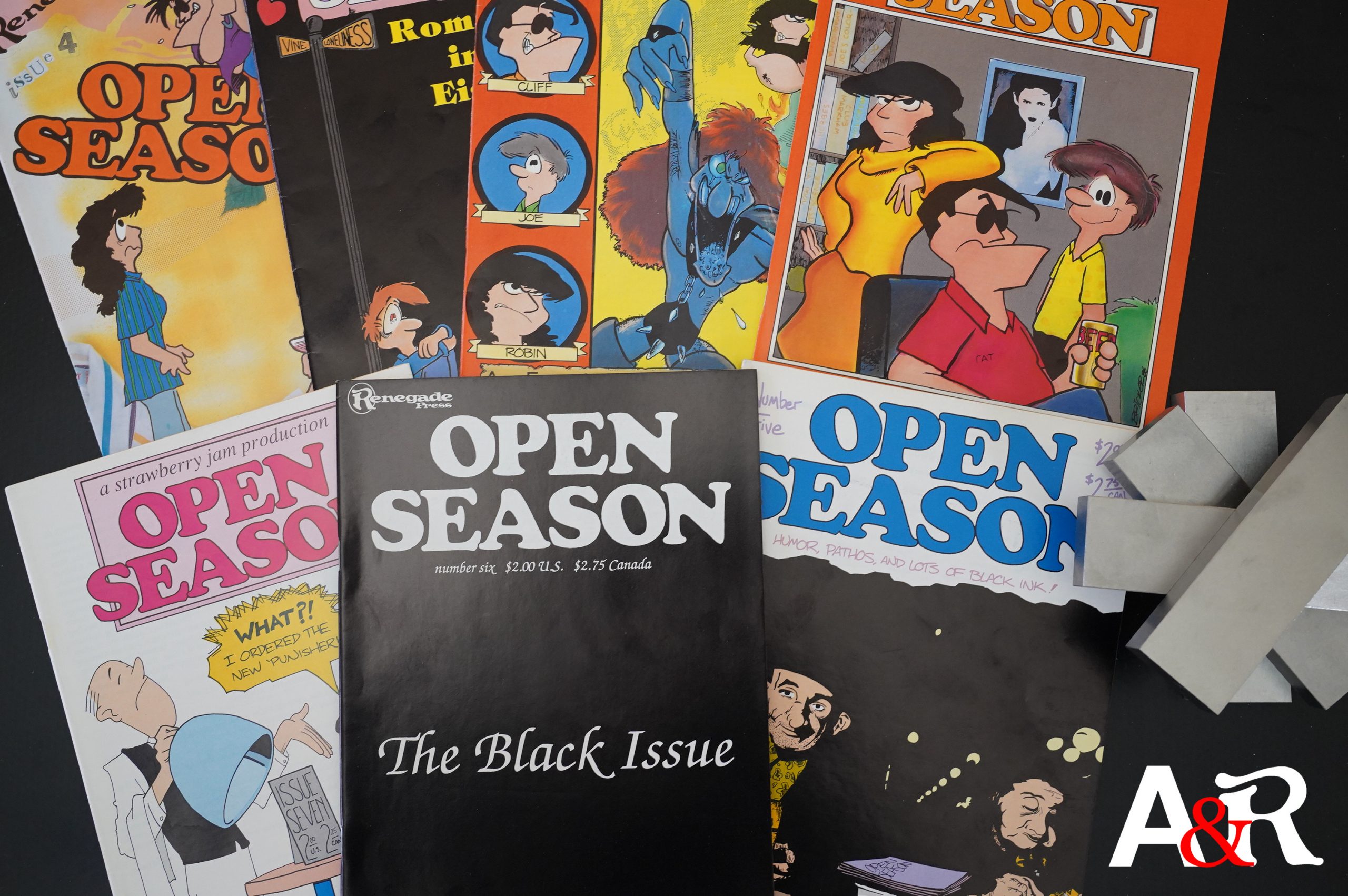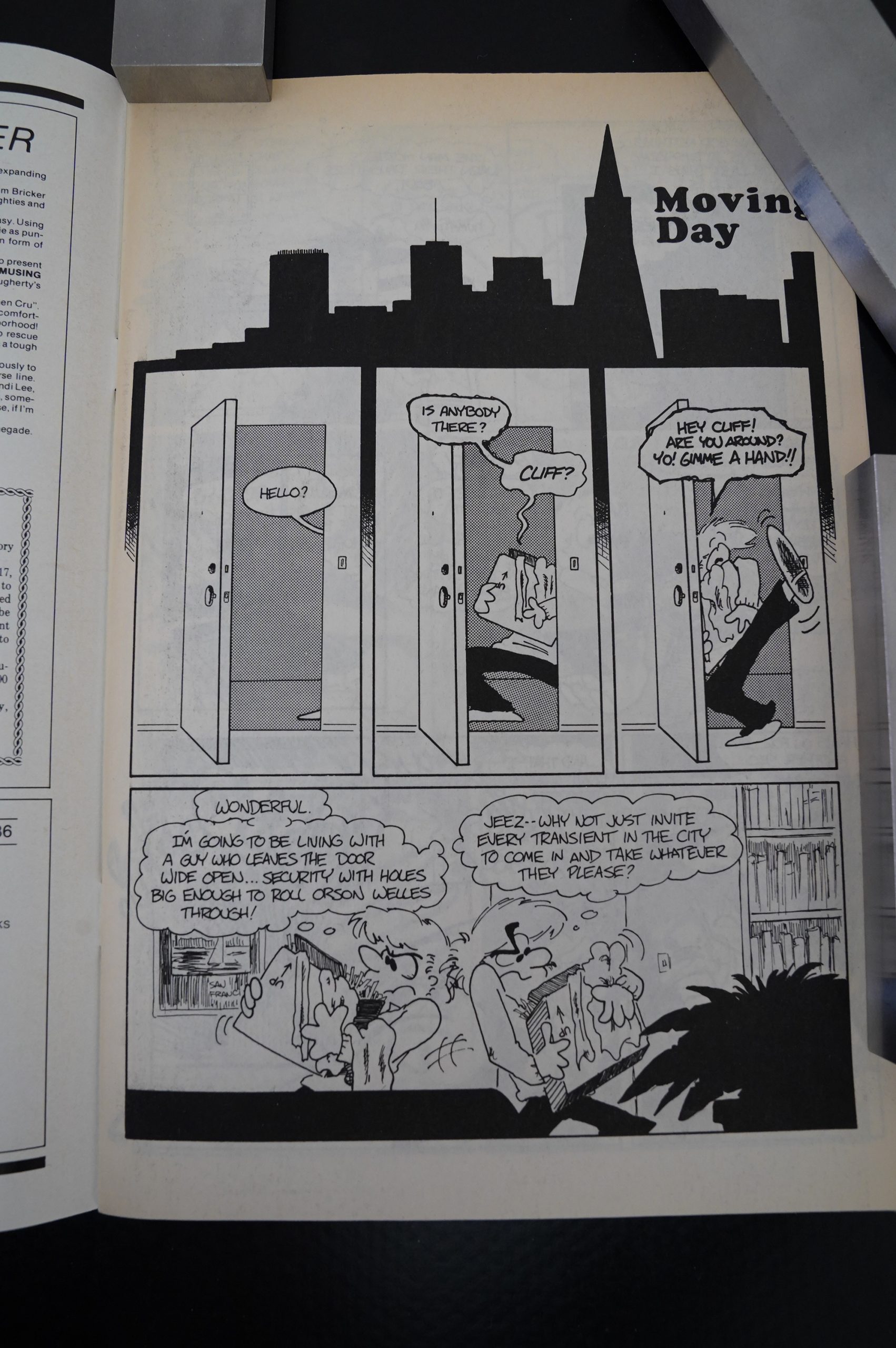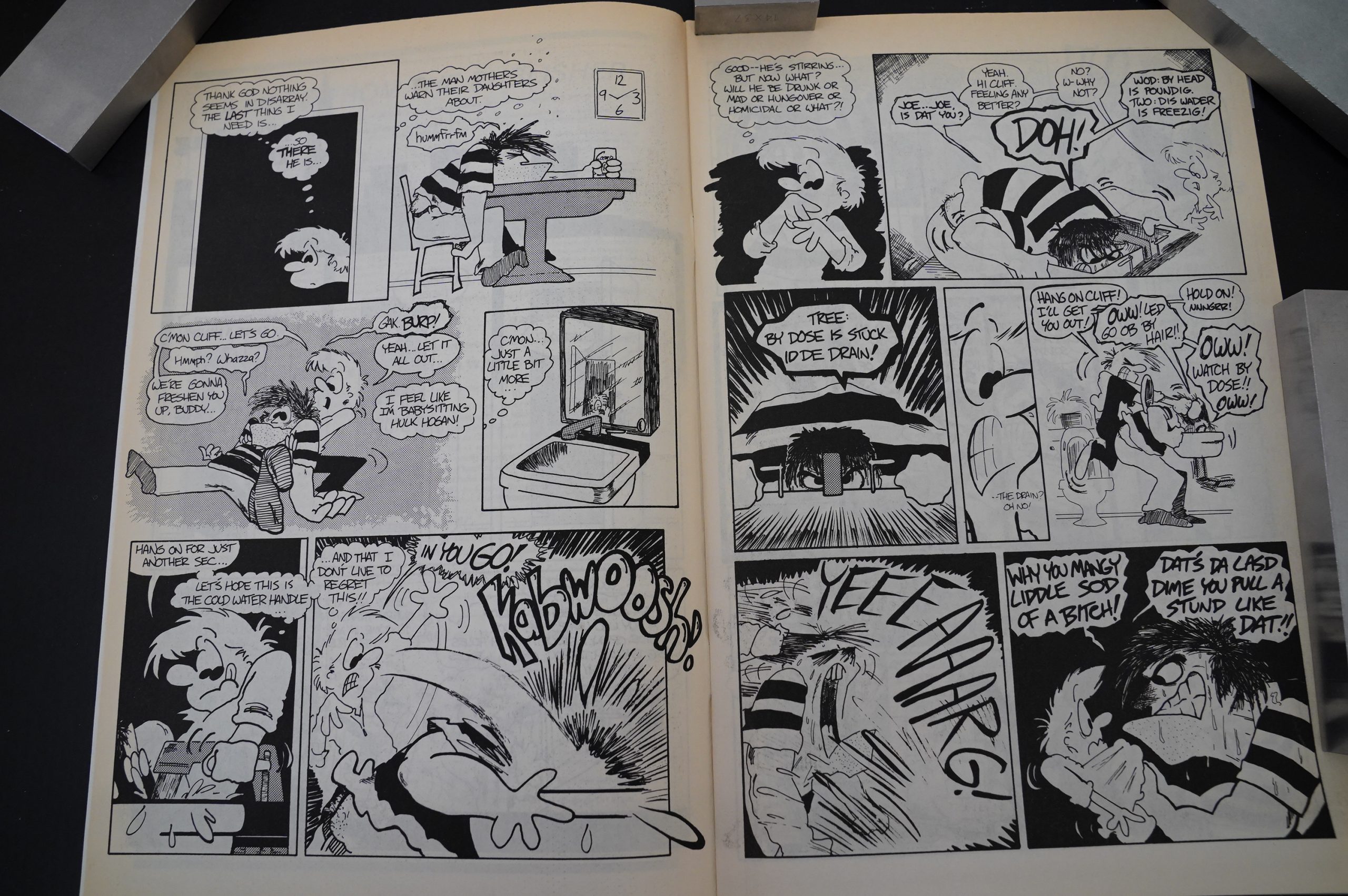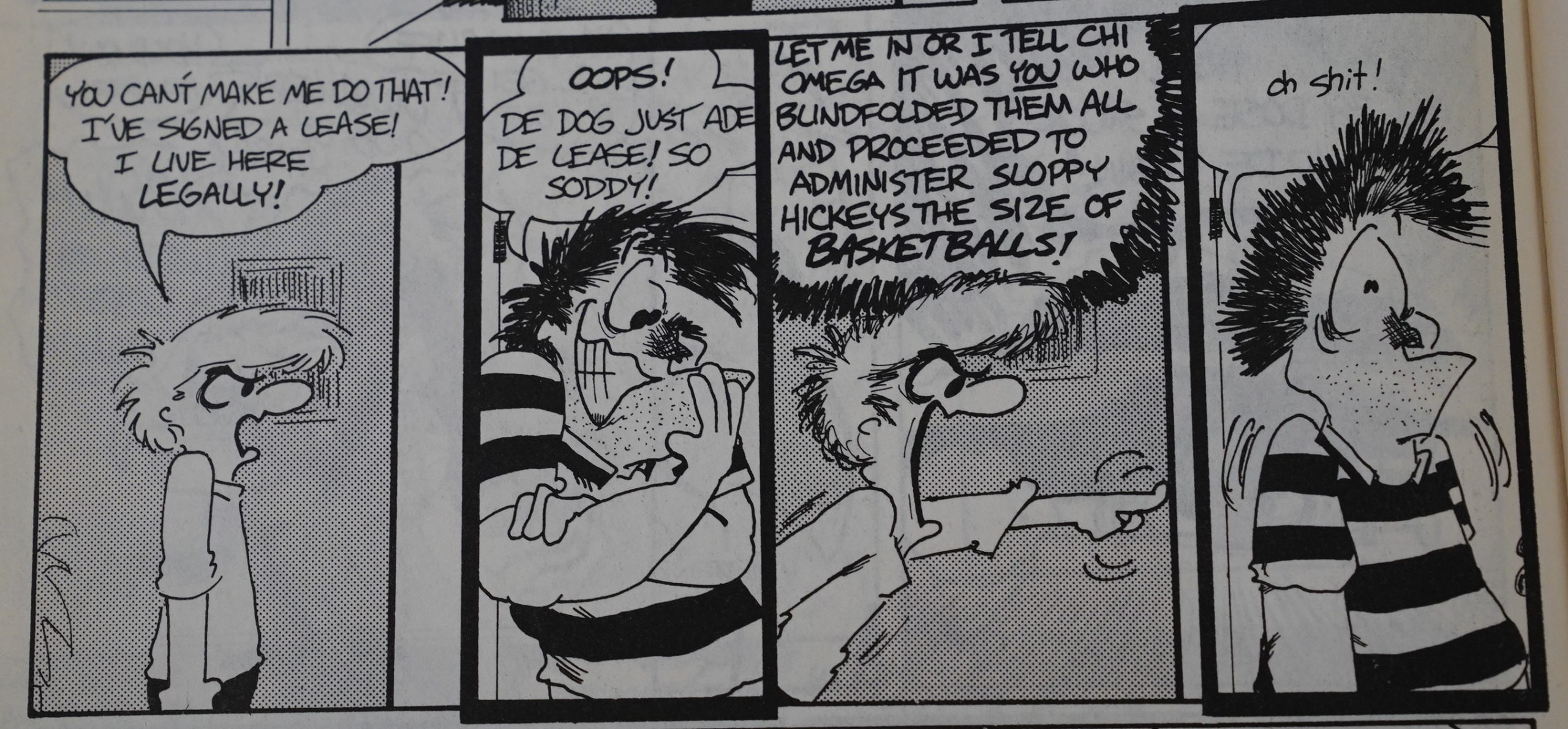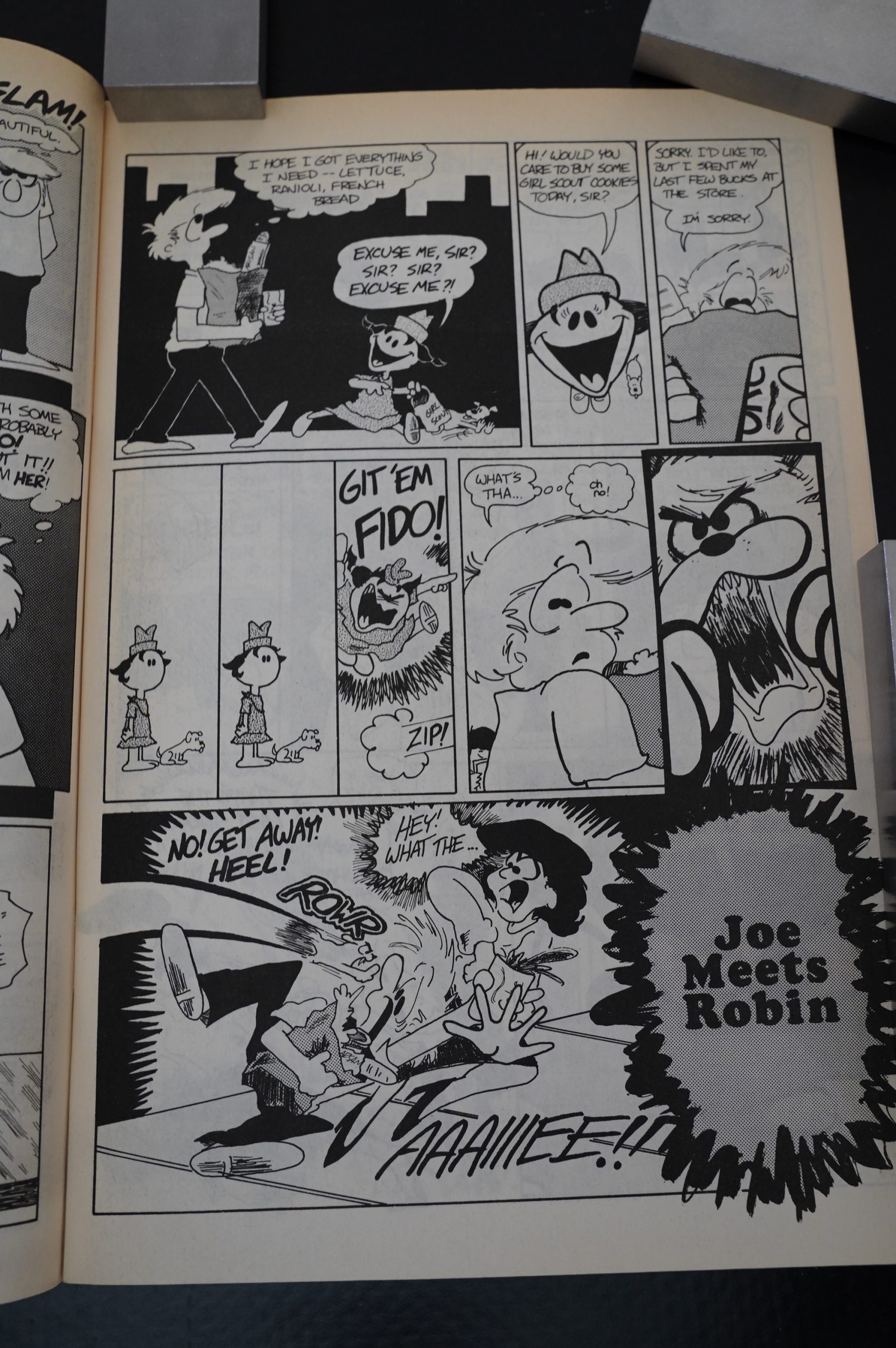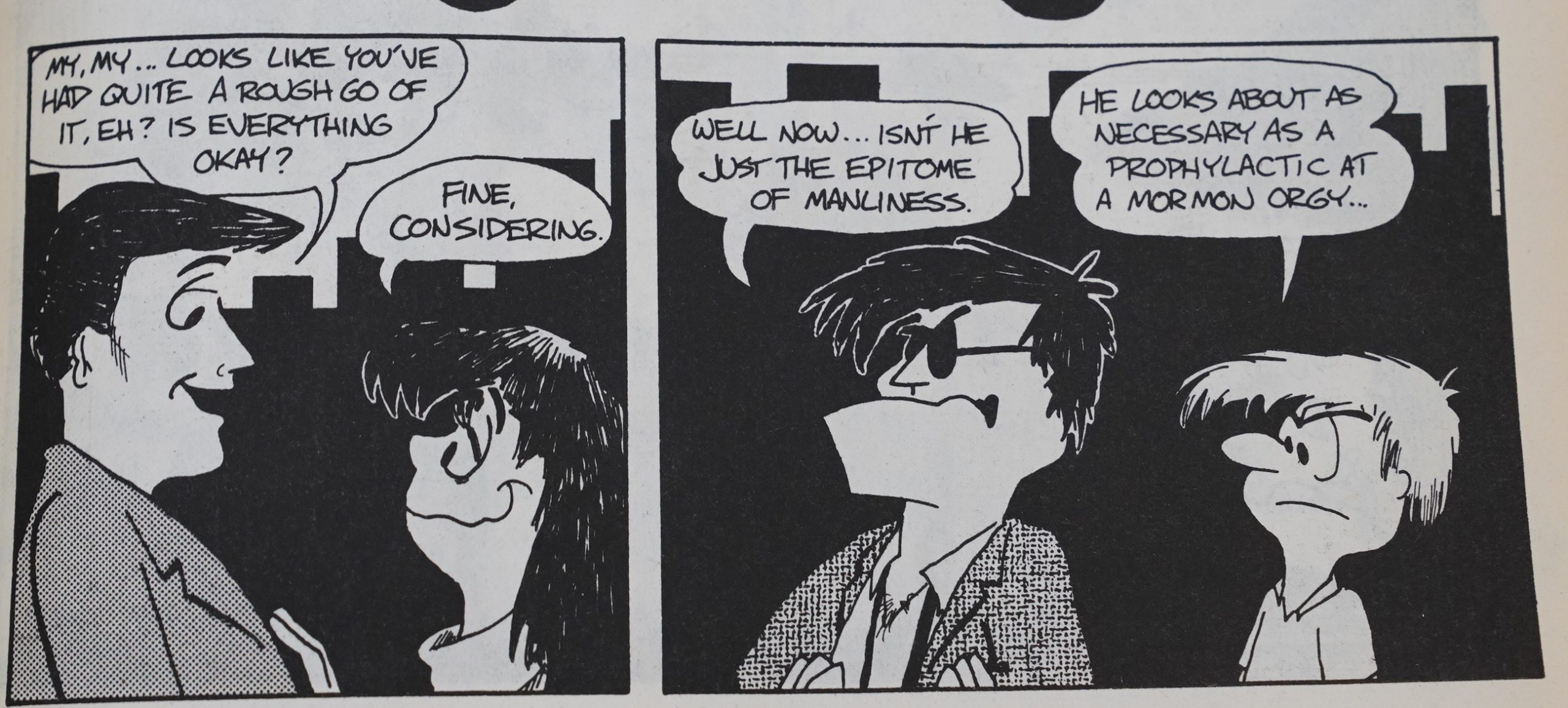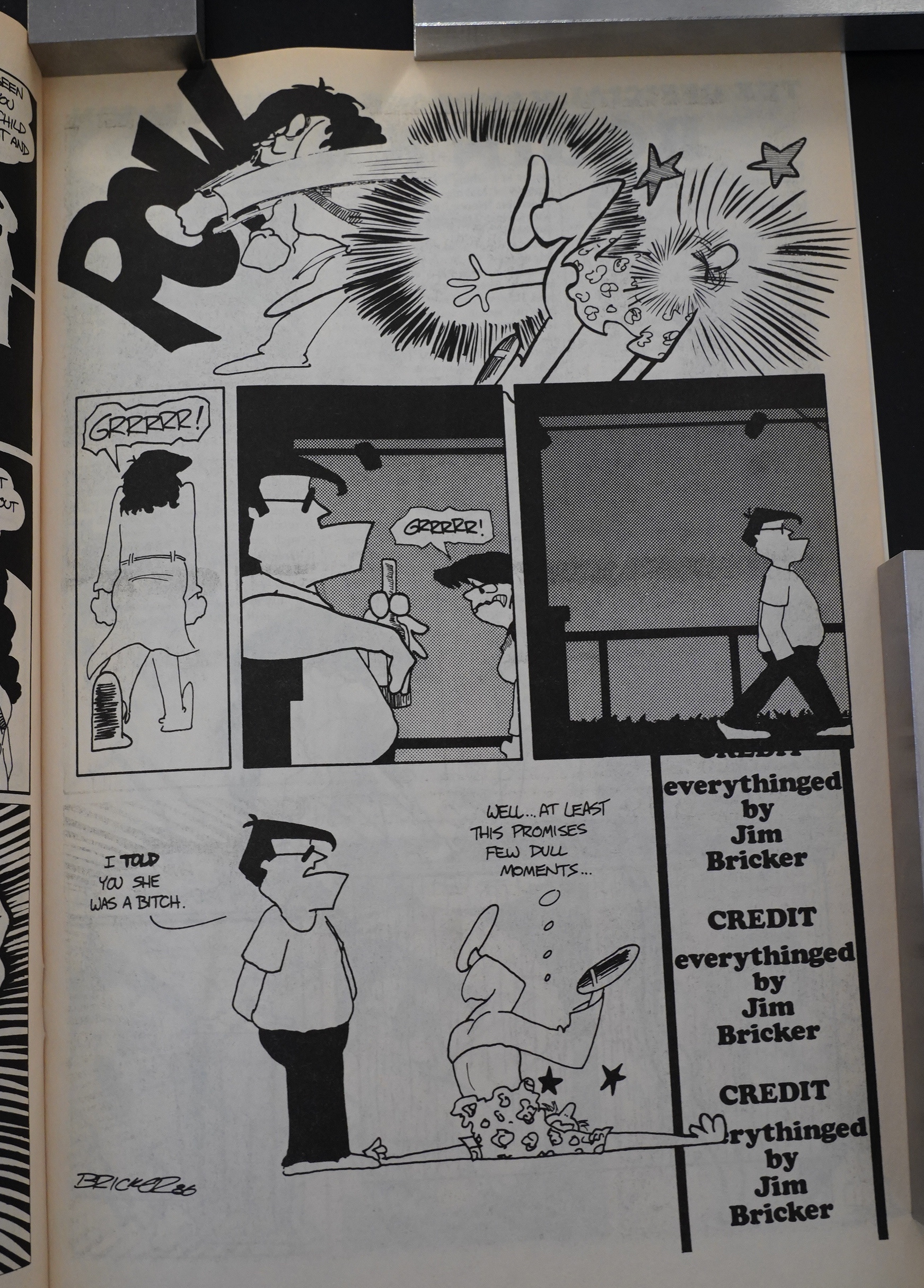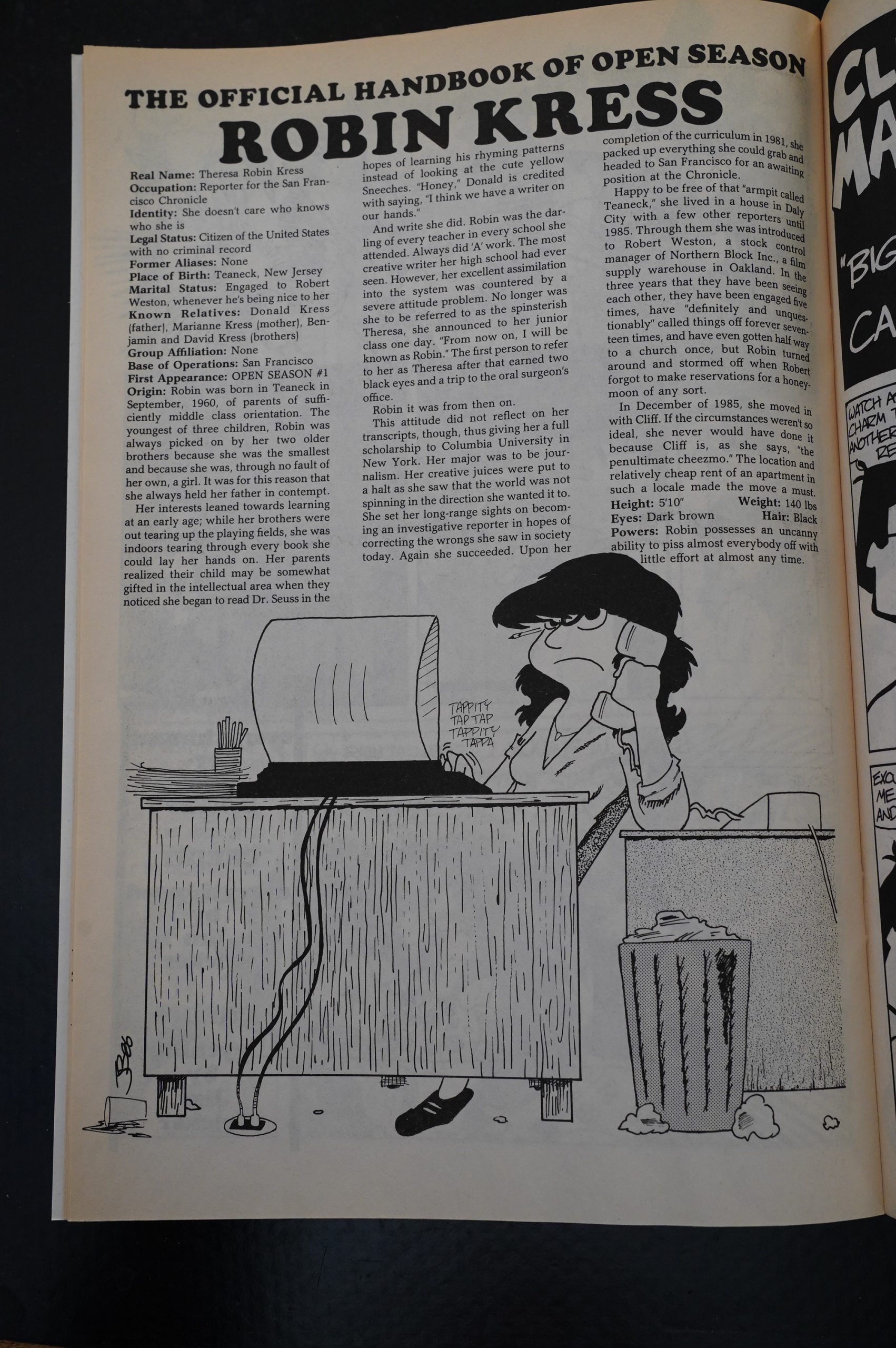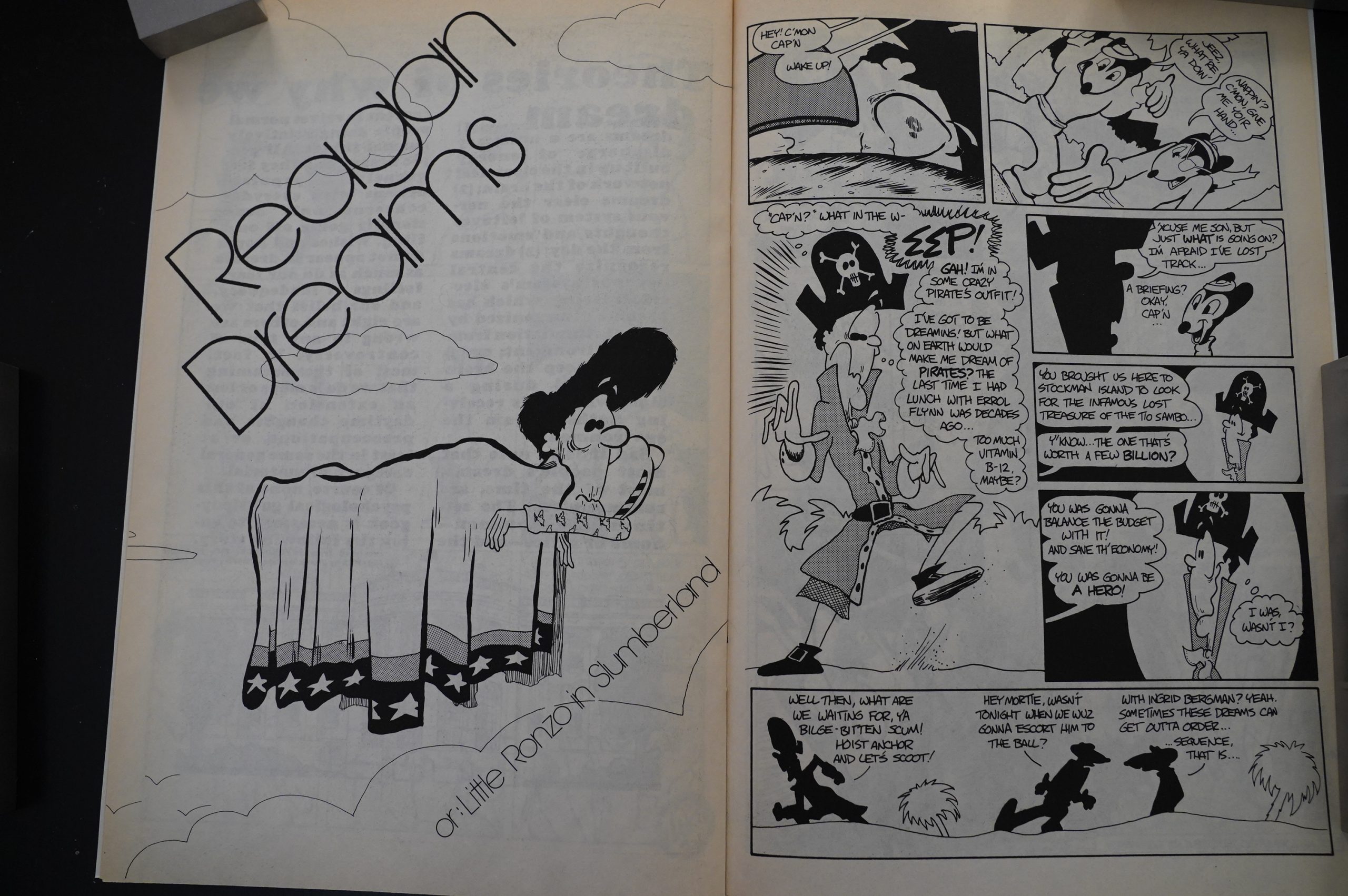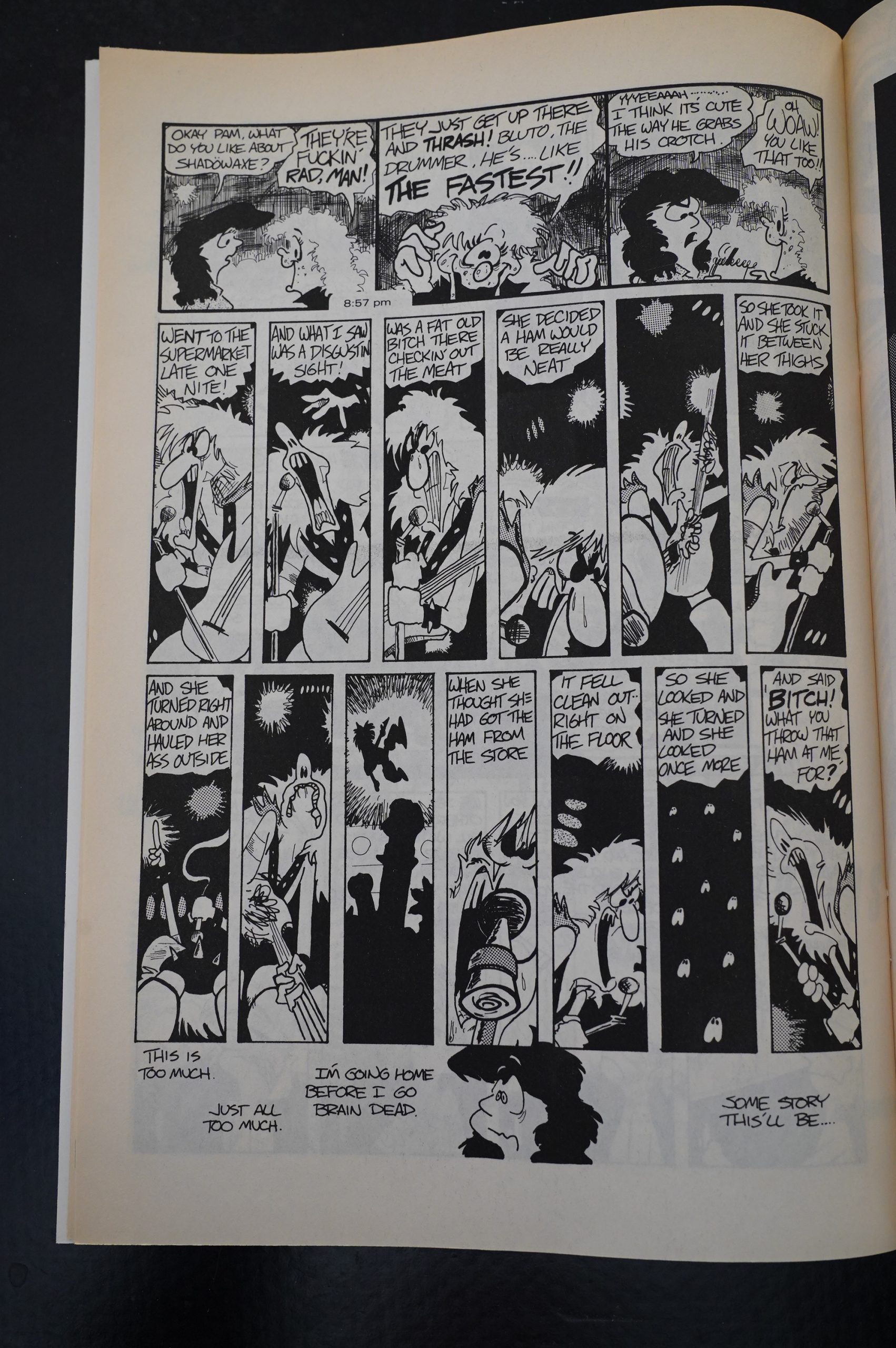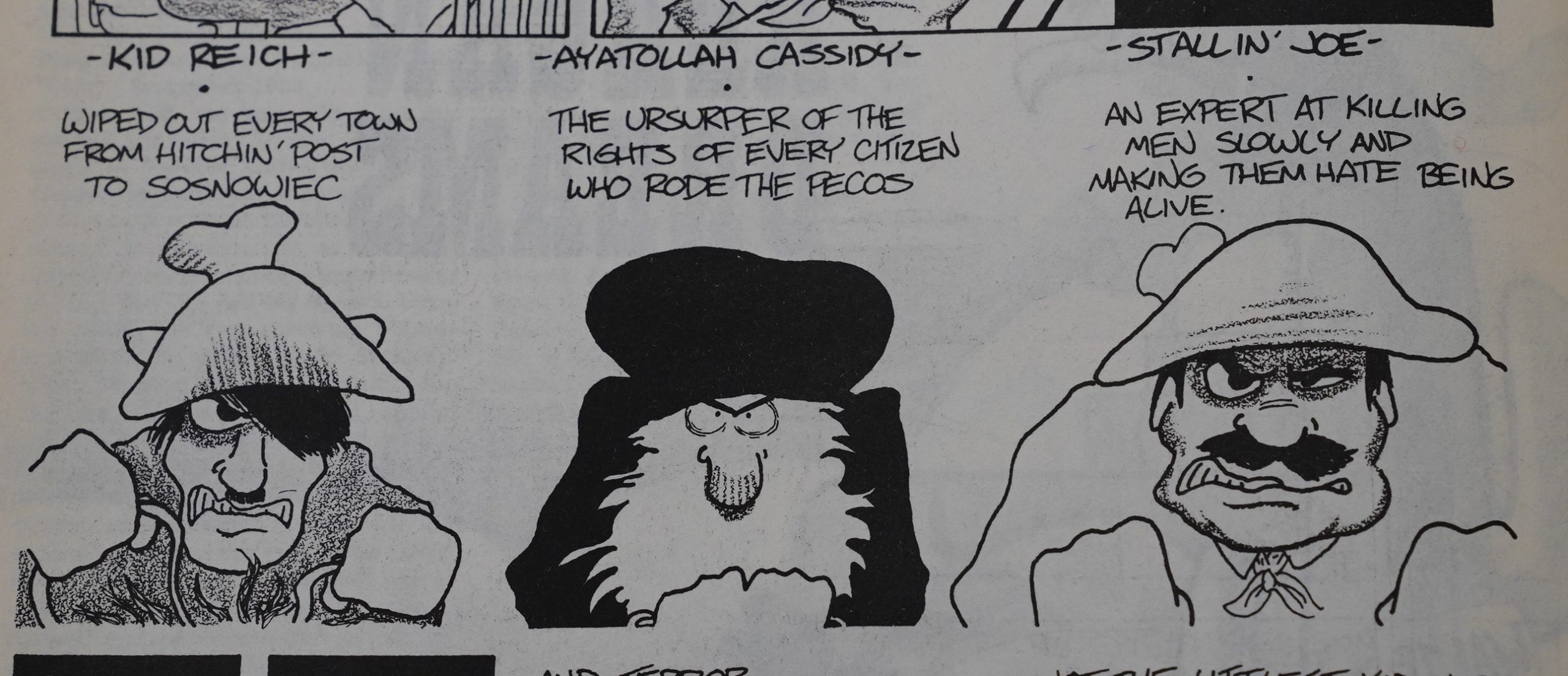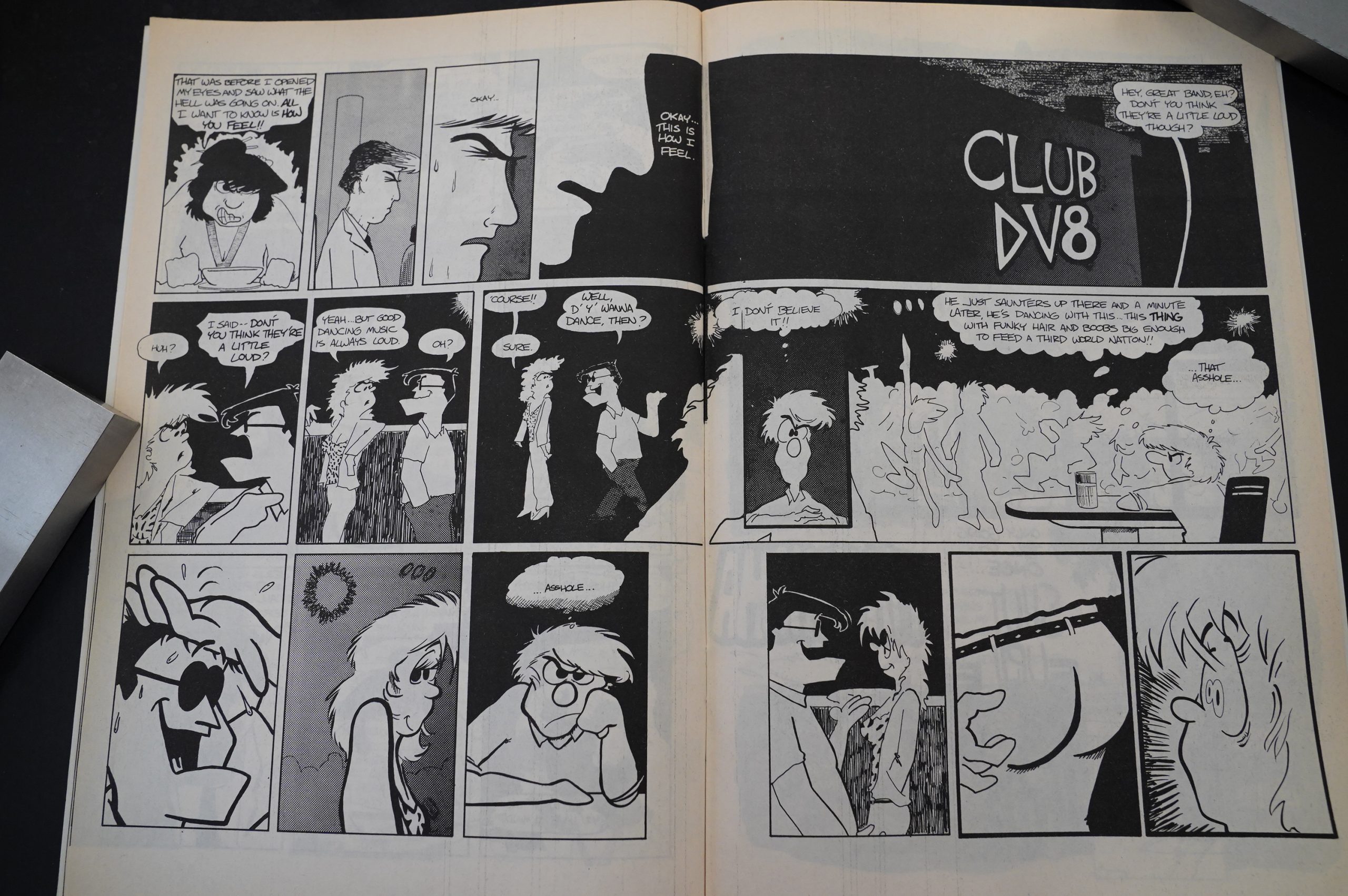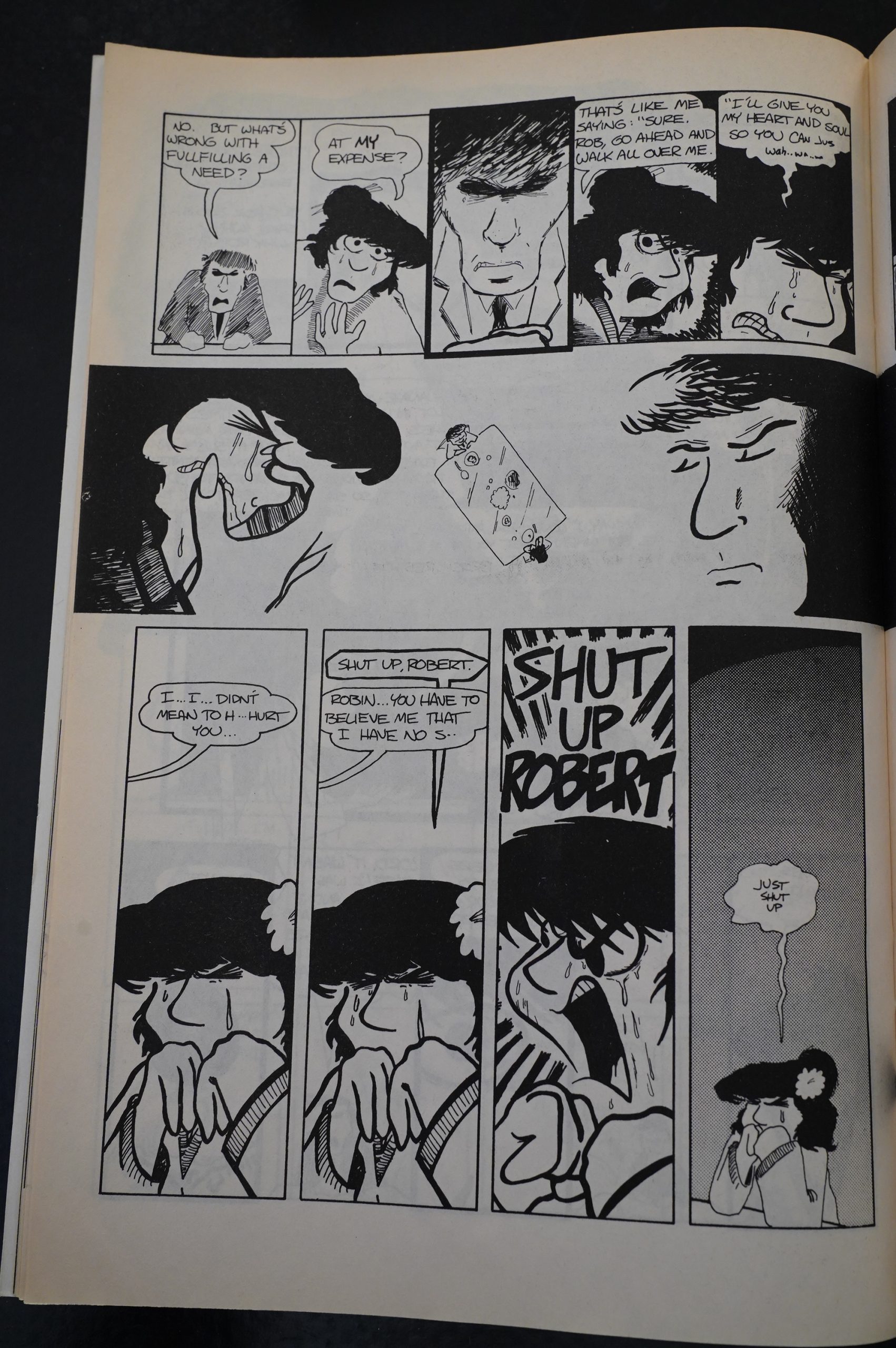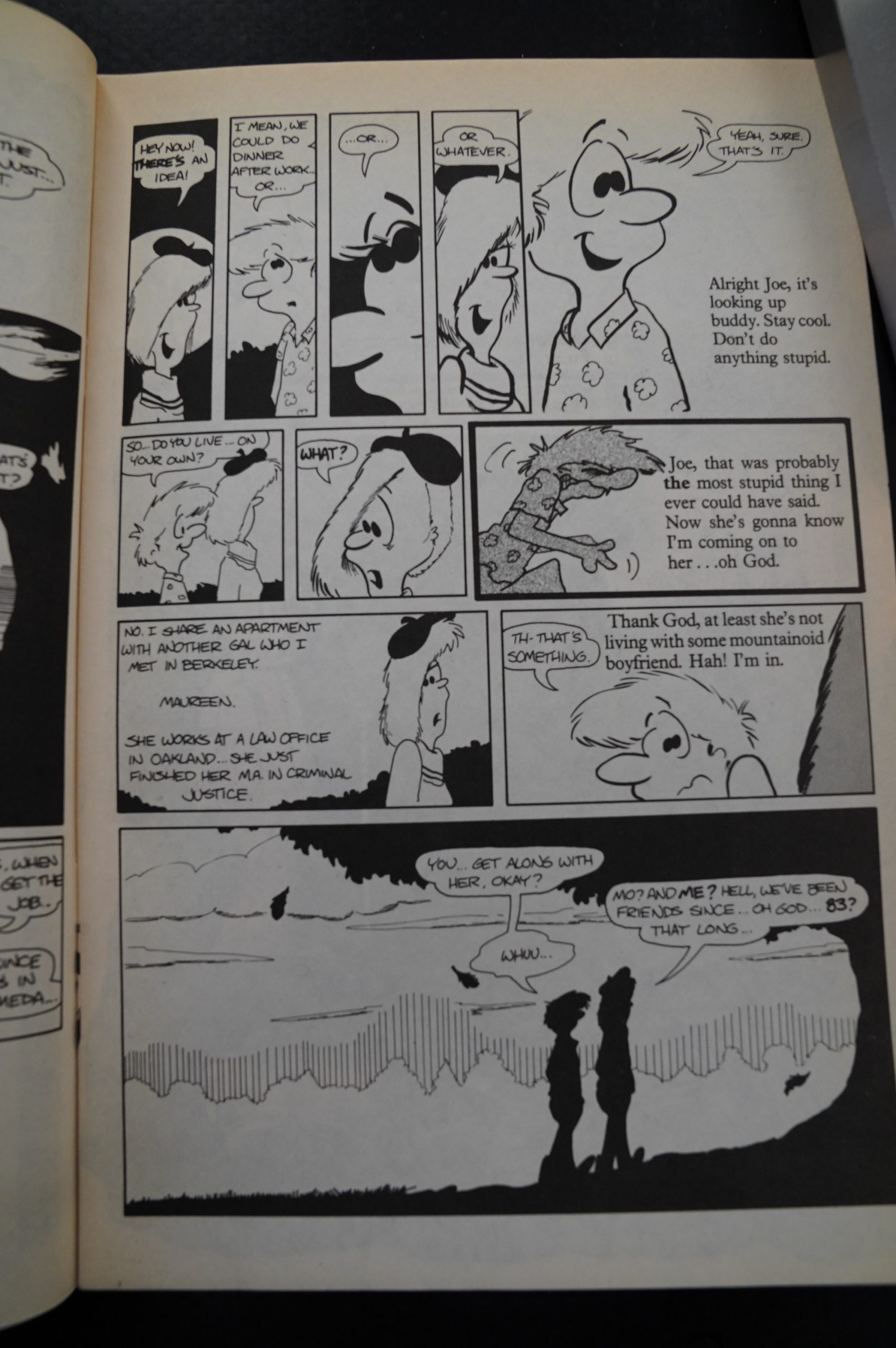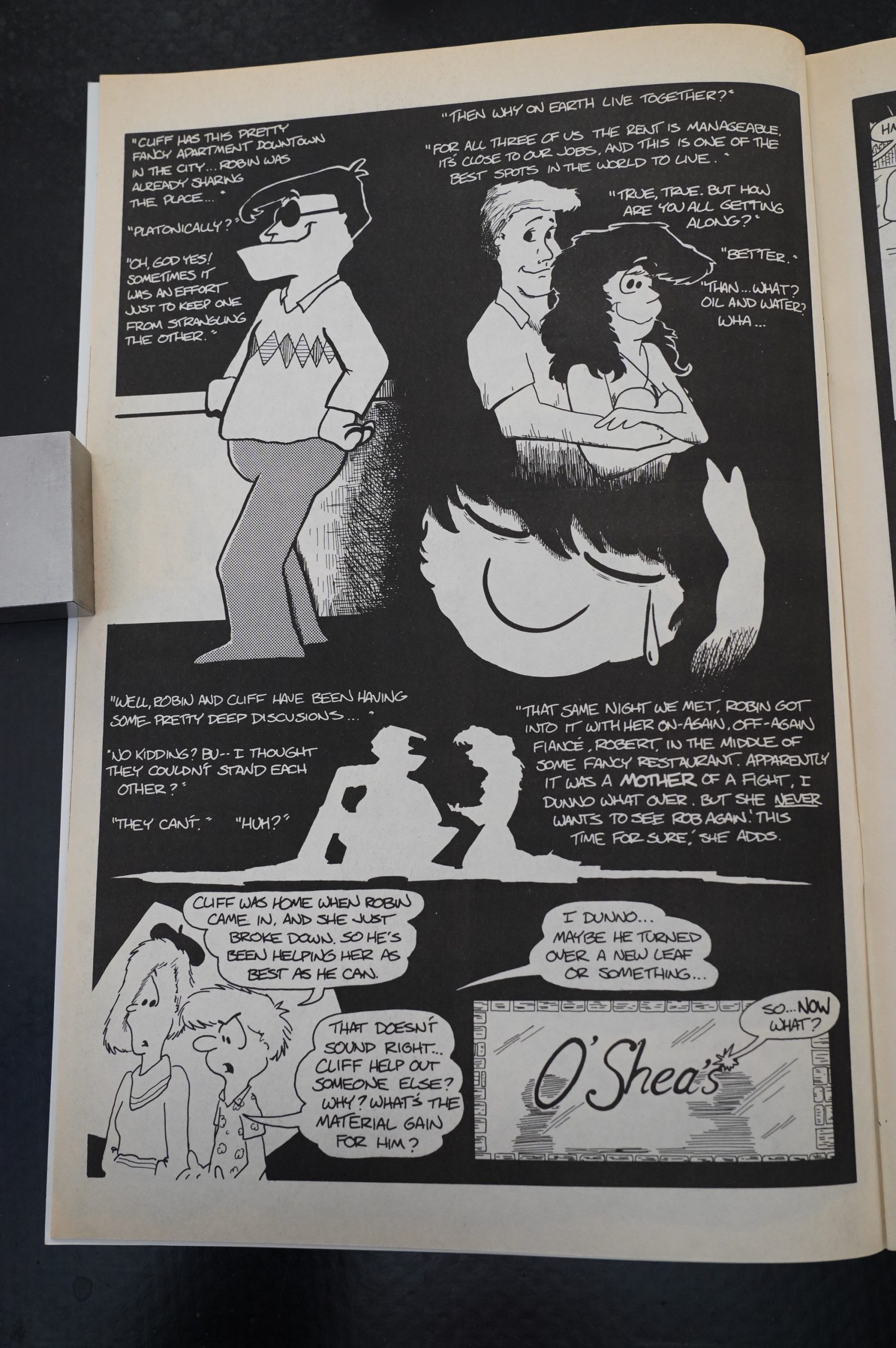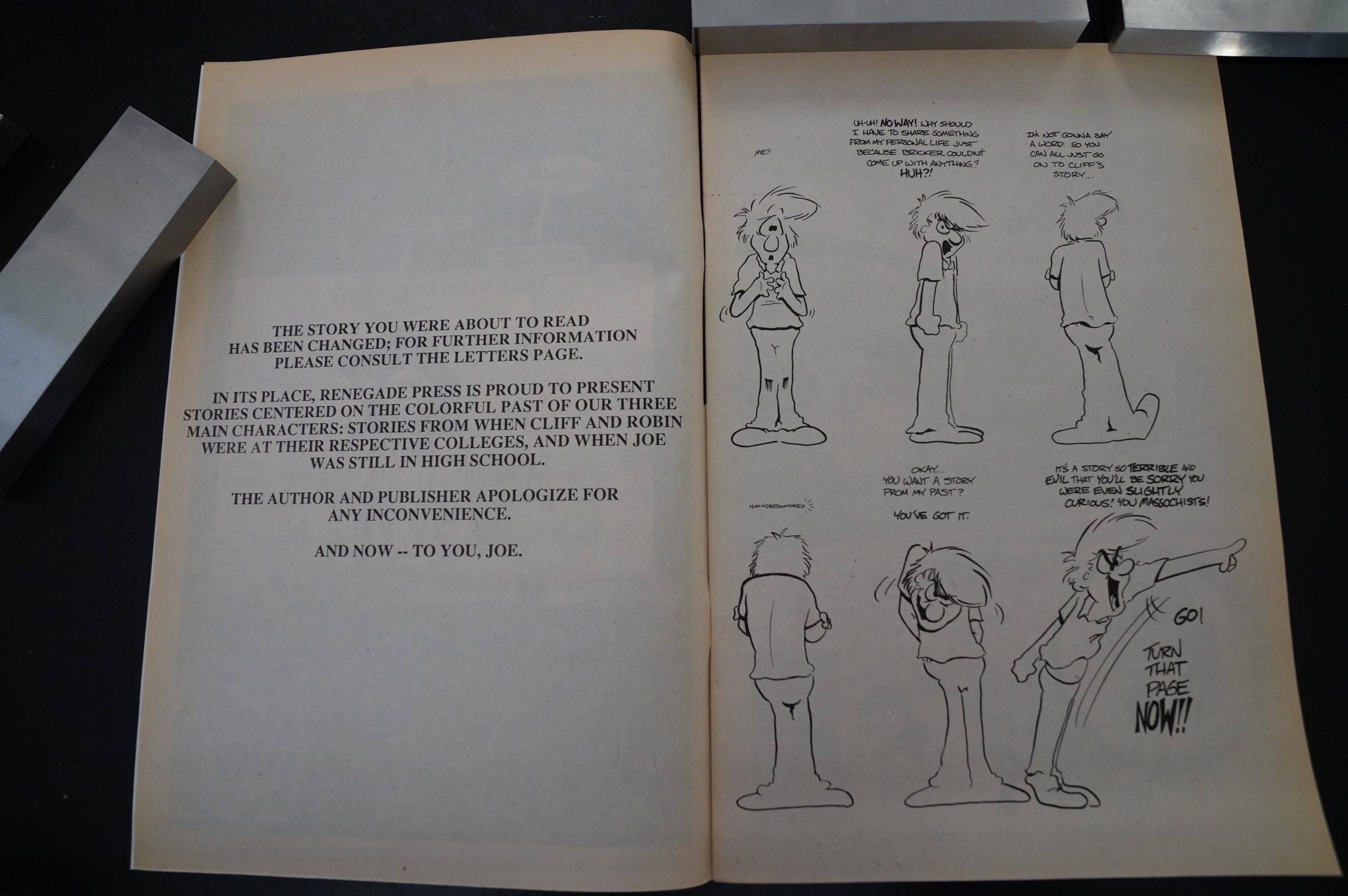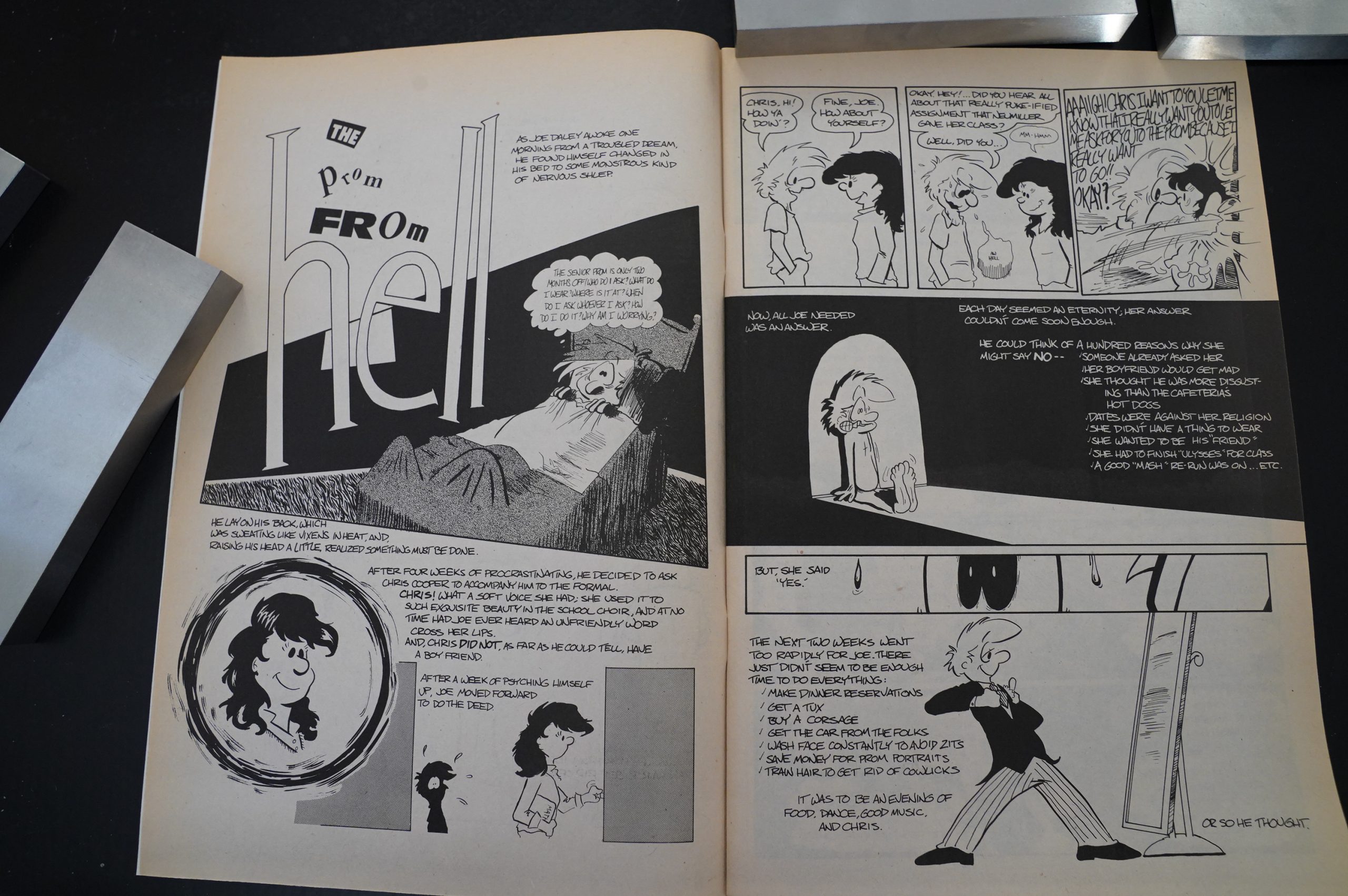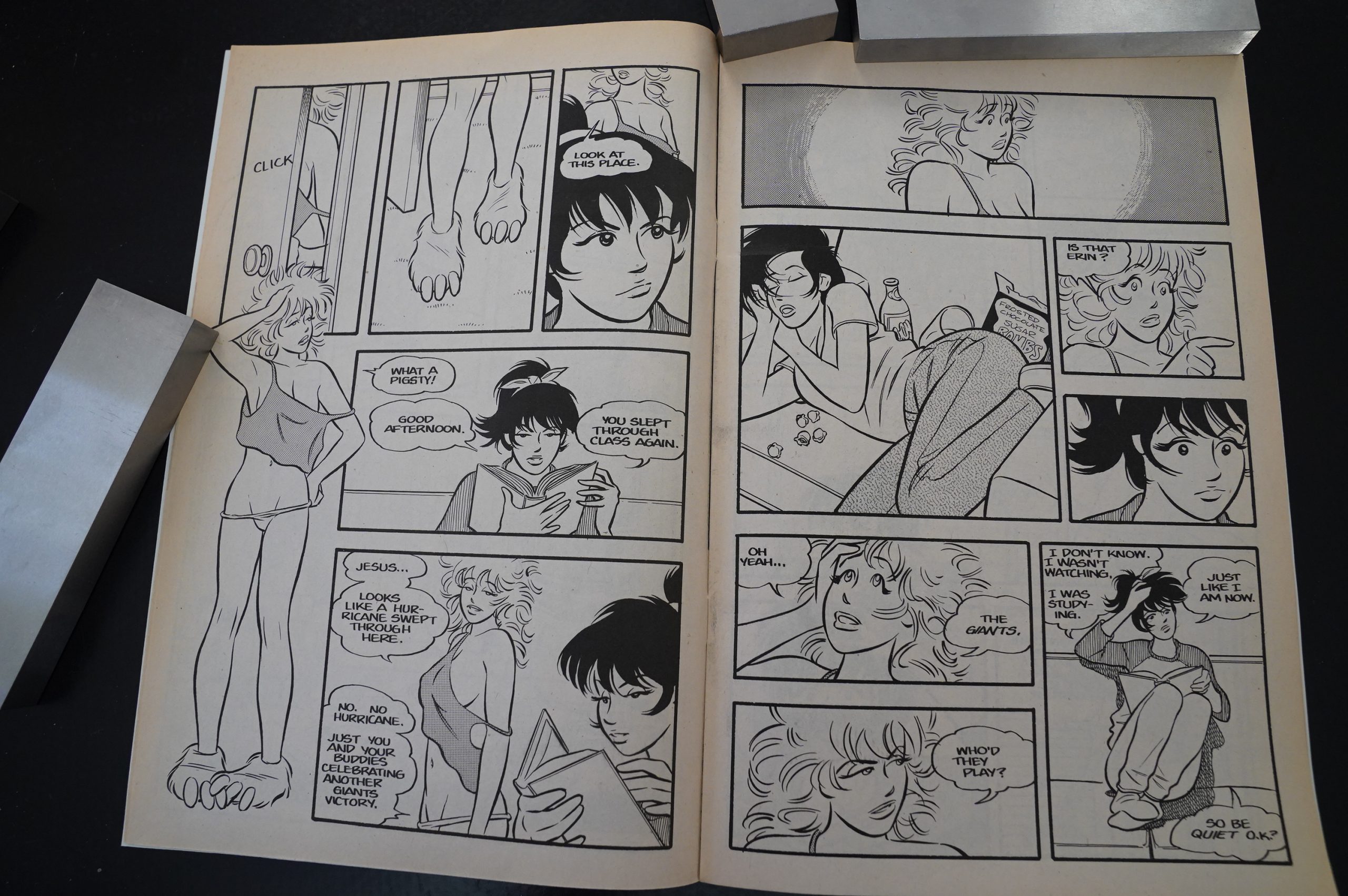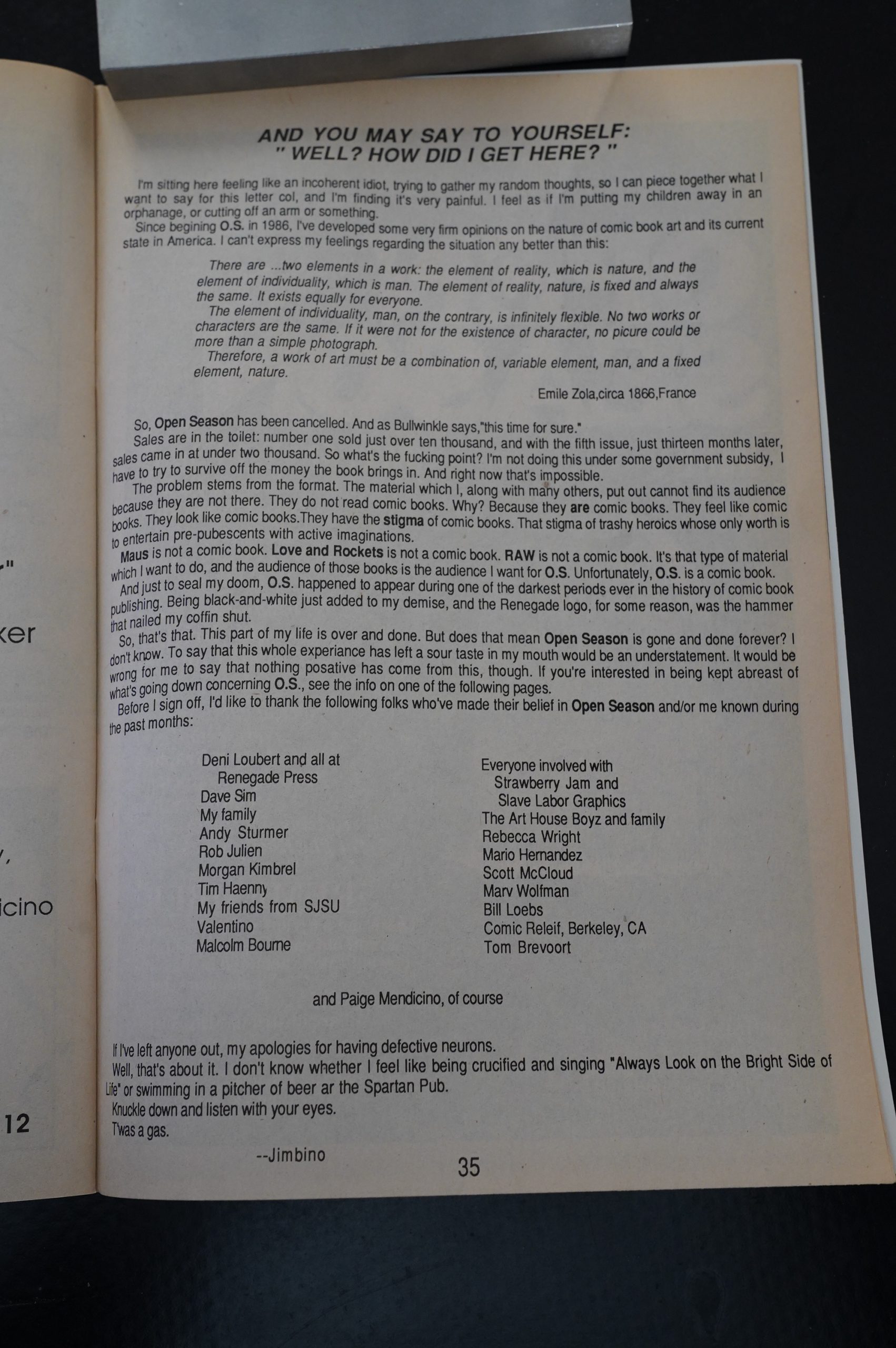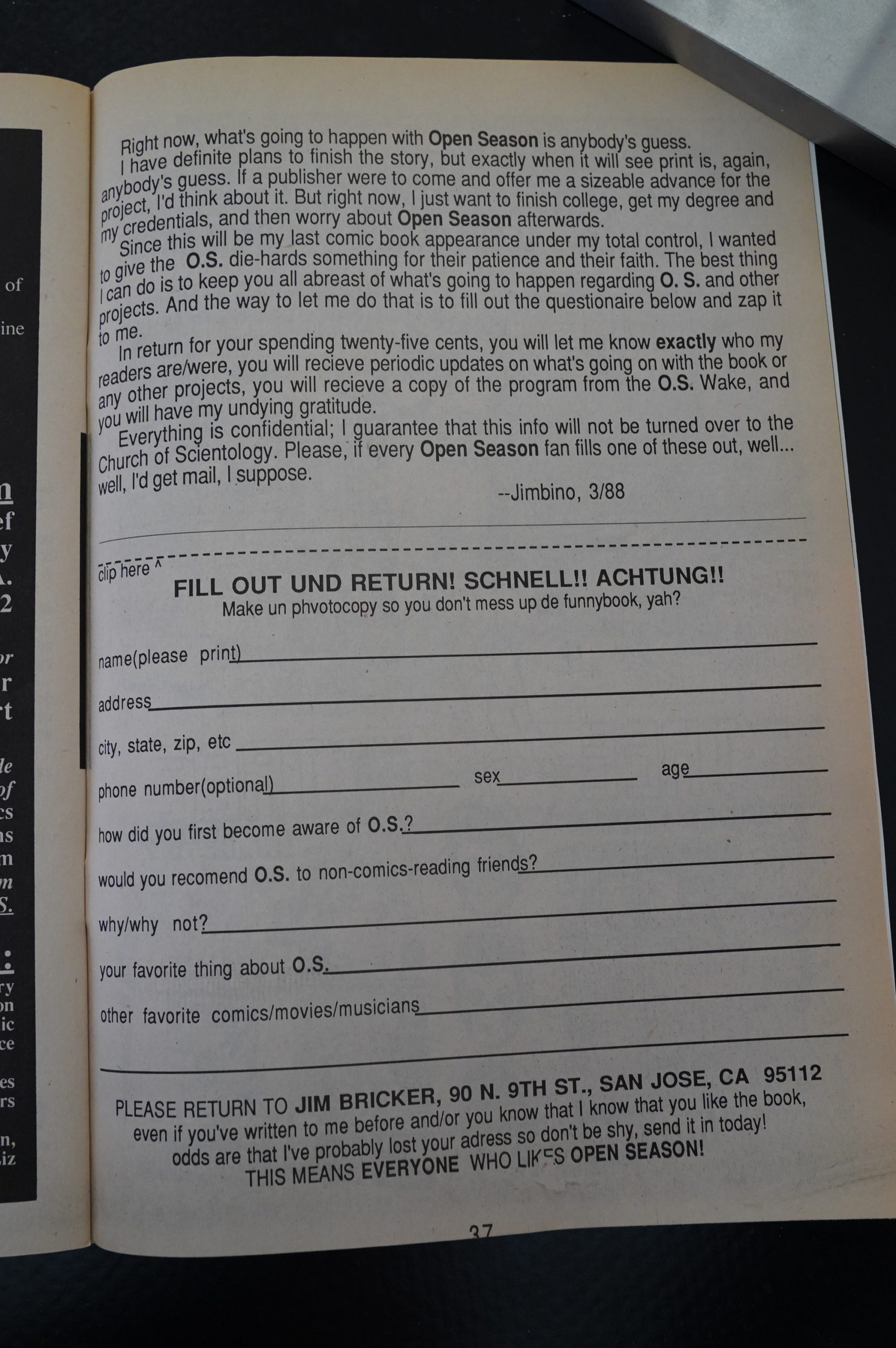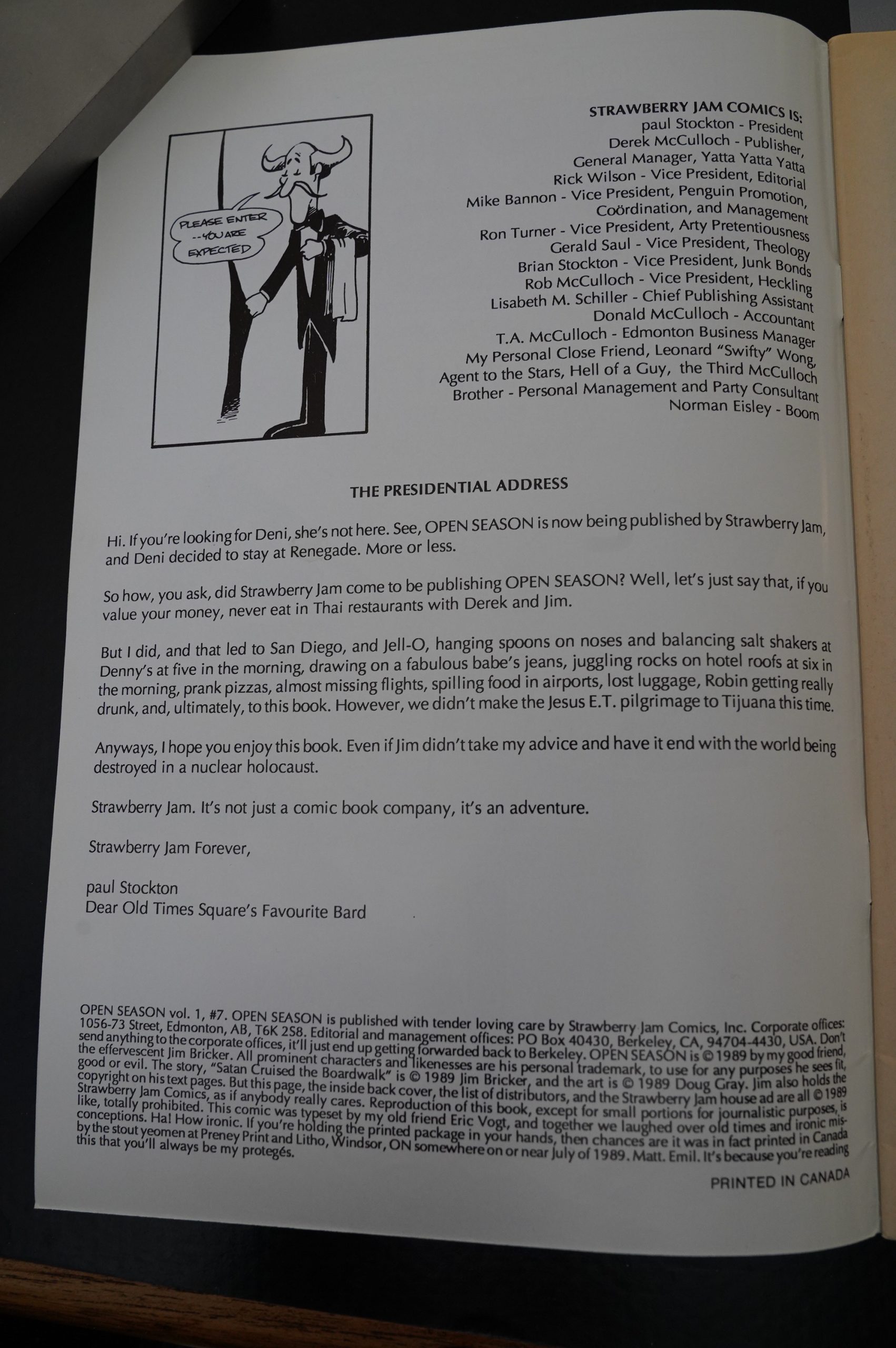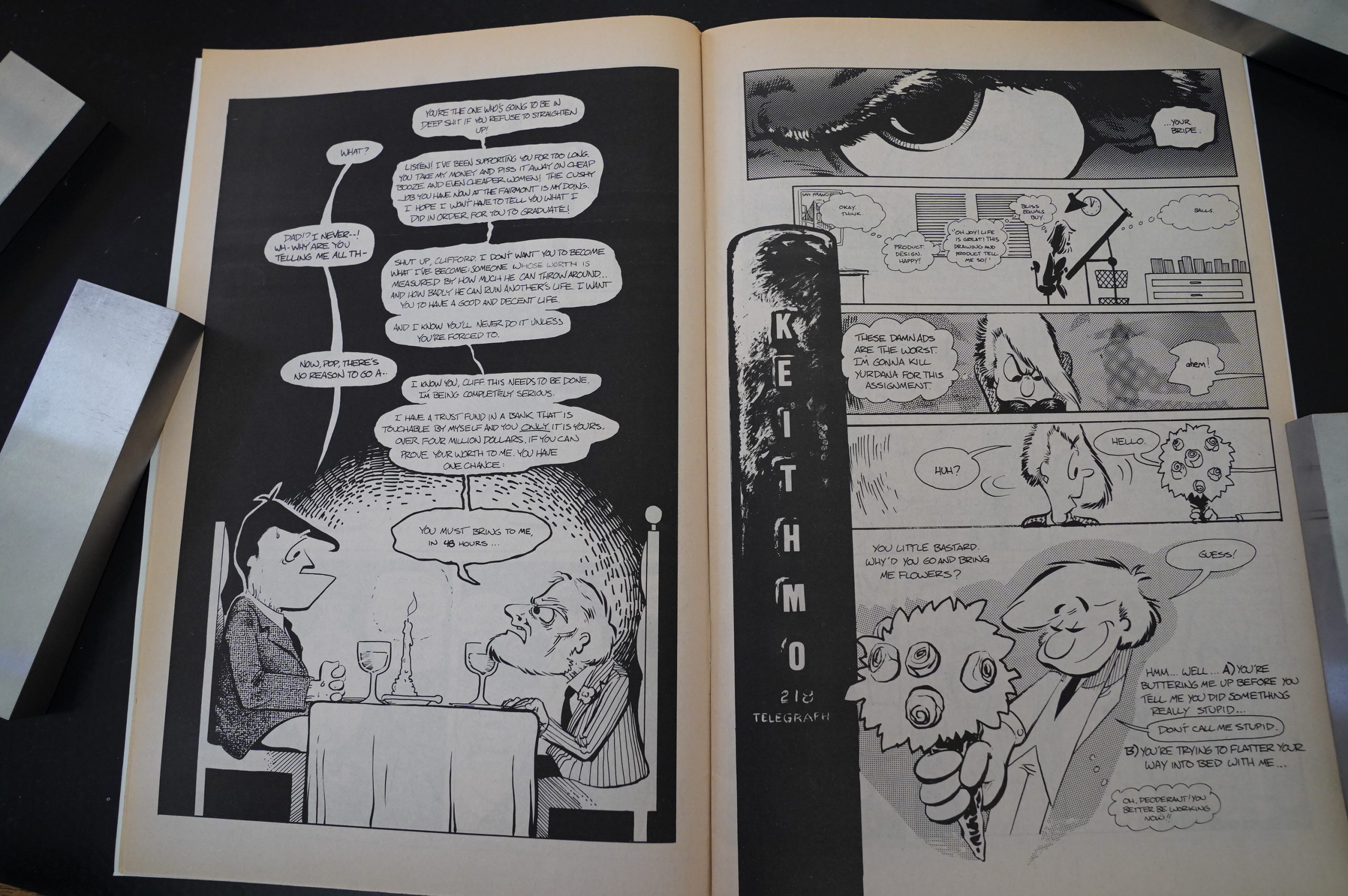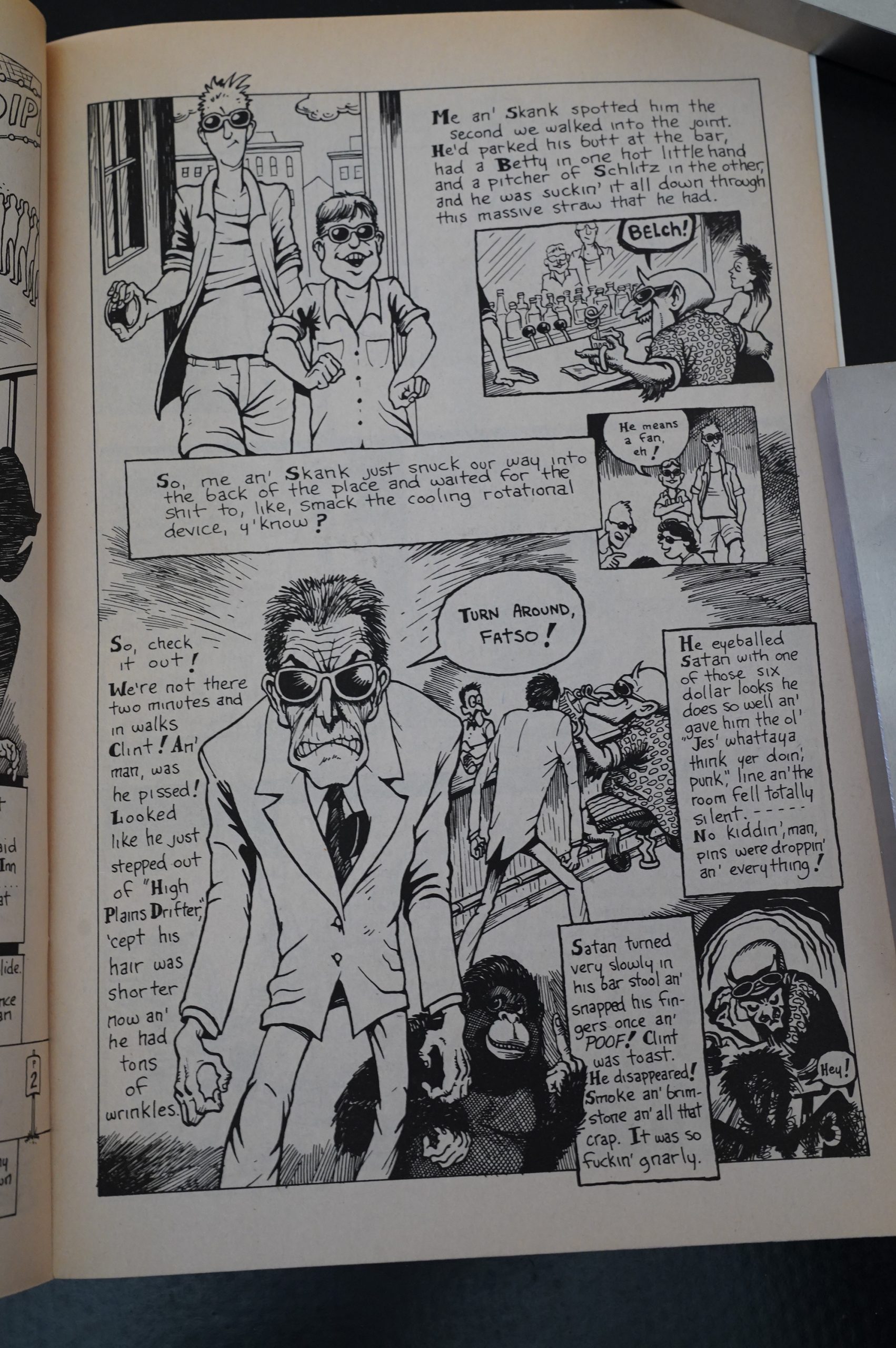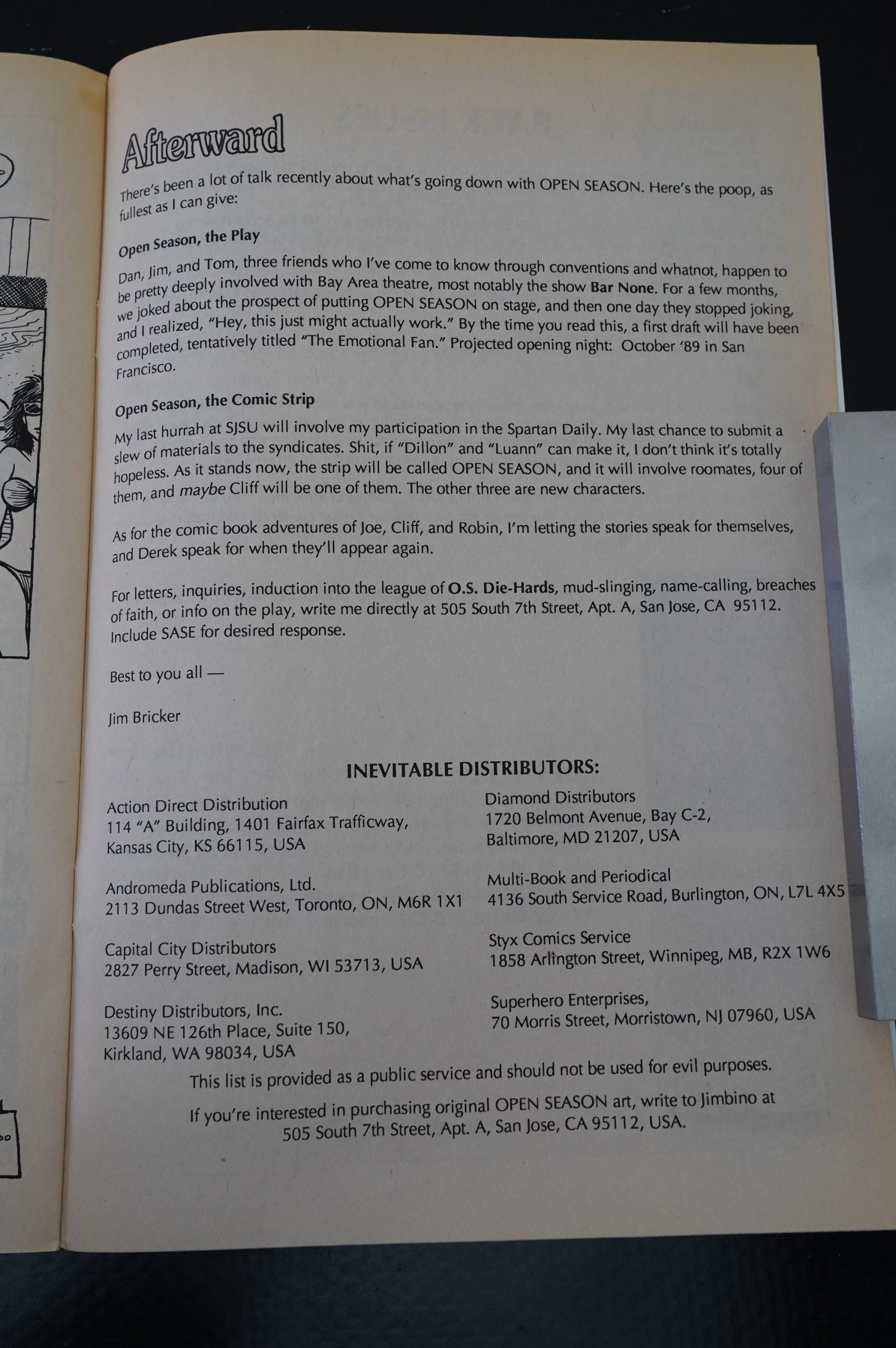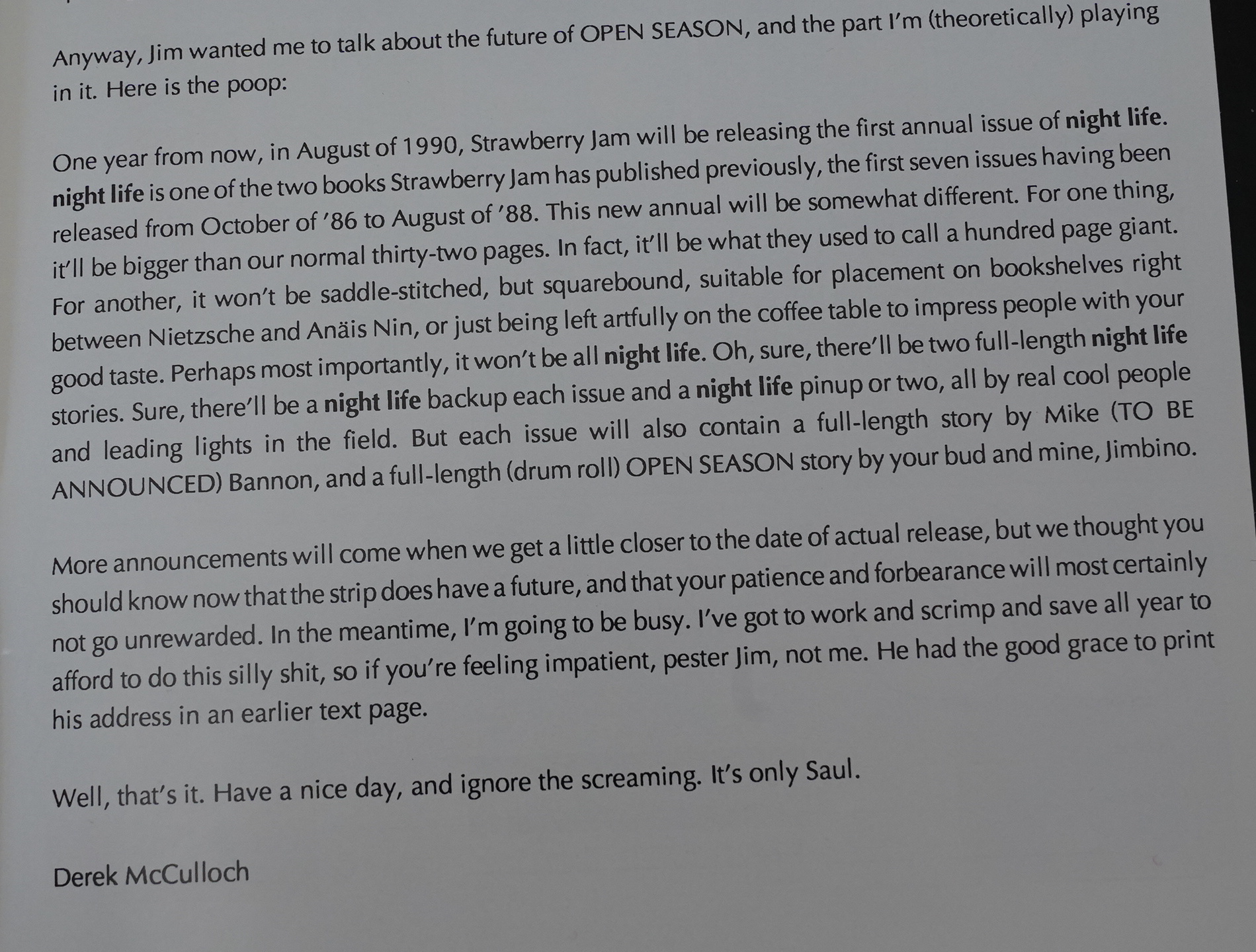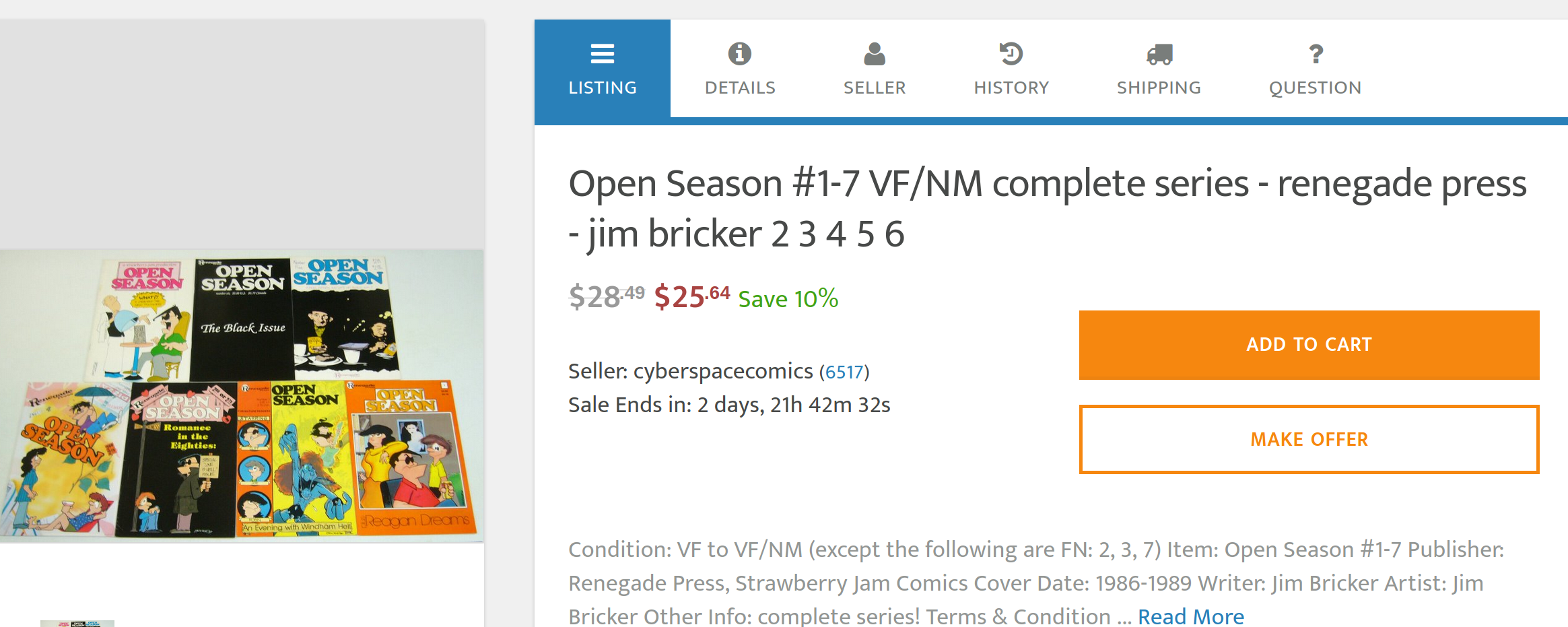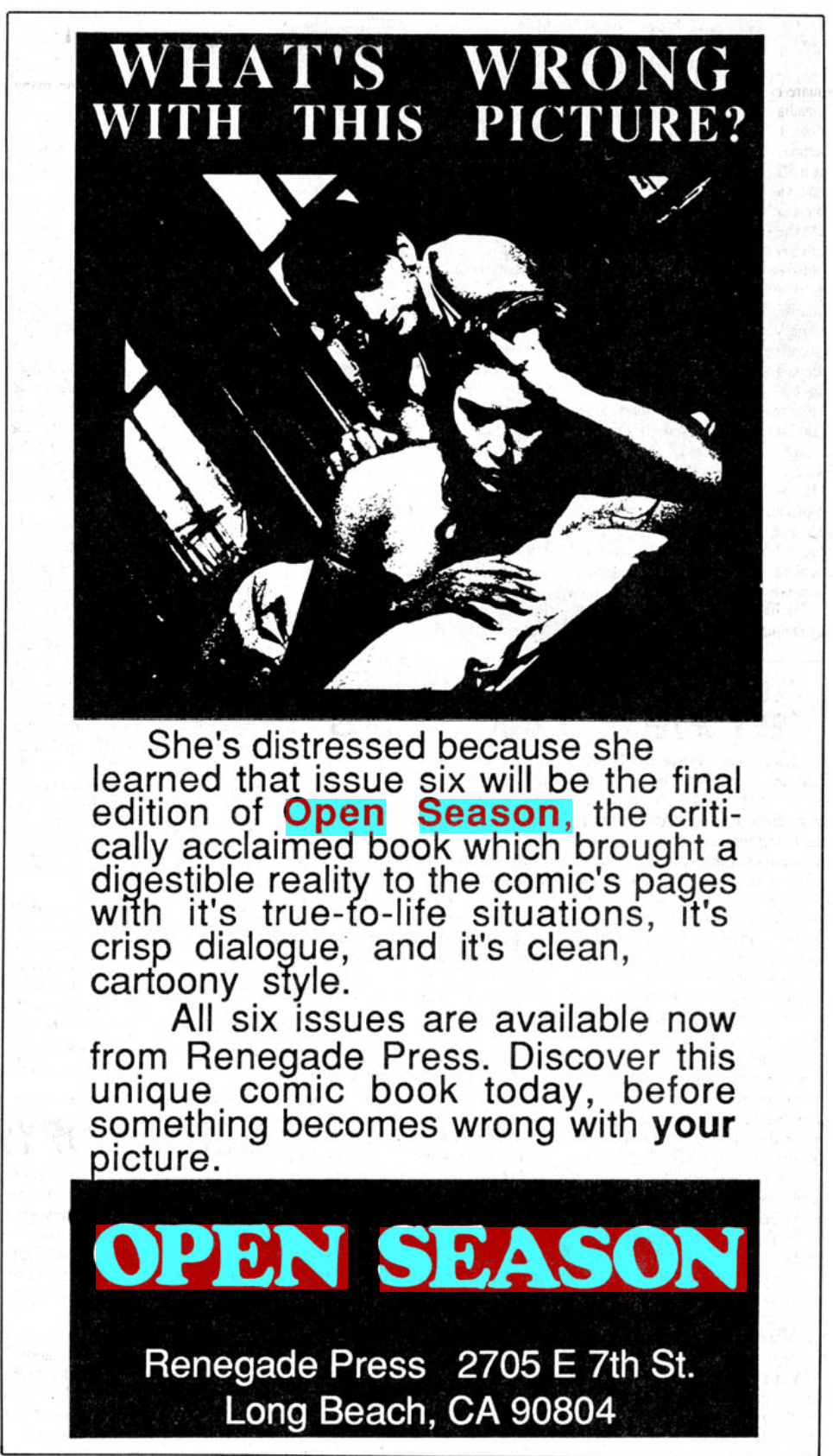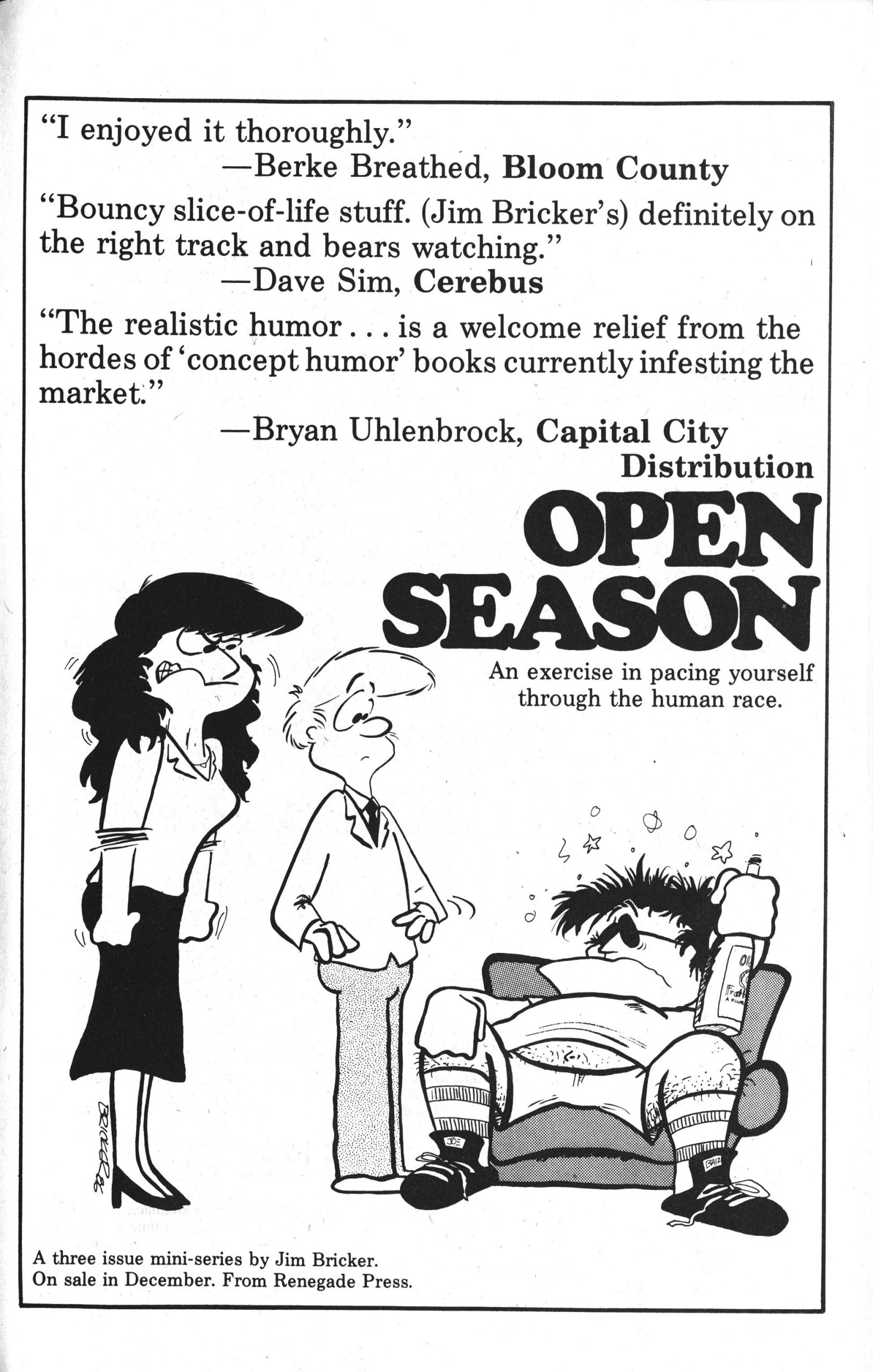Open Season (1986) #1-6,
Open Season (1989) #7 by Jim Bricker
Hey! I remember this series from when I was a teenager… well… OK, you got me: I just remember having about half of the issues, but I don’t remember anything about the contents. Except it being kinda… like… sitcom-ish? Or was it more drama-ish? Let’s read the first three pages together and find out:
Oh, yeah, definitely more sitcom-ish. The artwork has a nice kinetic thing going on, but the chops basically aren’t there much, so it’s just basically hard to tell what’s going on here.
And… if you happen upon a drunk guy — is your first impulse to drag him into the bathroom and run cold water over his head? Is that a thing that people do? I mean, outside of sitcoms?
So it feels like a book made by somebody very young. But I’m aboard.
Some of the jokes are kinda… you have to imagine that this could be funnier if what he’s saying made any sense. Why would these women let themselves be blindfolded and then be hickey-ed by… an unknown? And are these supposed to be in college?
I KNOW! I’m overthinking it. It’d work better as an actual sitcom, because then it moves on without giving you time to ponder the complexities of the gag. (So to speak.)
So we’ve got a classic sitcom setup: The jock, the nerd and the bitch. (Don’t blame me! That’s what the jock calls her.) With lots of over-the-top slapstick violence every other page.
“He looks as necessary as…” Necessary? See, there’s a joke here, but it needs some work.
Bricker adds a credits crawl to the end to emphasise the sitcom connection, I guess.
I guess people don’t do these kinds of performative domestic violence bits in humour comics any more? (She’s angry with the nerd because he spilled coffee over some of her papers thereby somehow “ruining” her research. I know, I know. It’s almost there; it just needs some work.)
In every issue, we get a bio of one of the characters.
We get Reagan Dreams as the back-up feature. It’s a riff on Little Nemo in Slumberland, and Slave Labor did an issue of this stuff.
Bricker tells us that there’s three issues planned, and then they’ll see…
Oh, haven’t seen that ad before. It’s for Holiday Out, which I’ll cover later in this blog series…
The second issue is a lot more coherent. Bricker somehow manages to tie all the three characters into a plot involving a heavy metal band, and hi-jinx ensue.
I had assumed that Bricker was very young, but this take on What The Kids Today Listen To kinda smells middle-aged…
Bricker’s artwork is so basic that it’s nice that he labels these caricatures… of the three easiest people in the world to draw. That’s supposed to be Hitler, Khomeini and Stalin.
The storytelling is mostly pretty straighforward, but when Bricker tries doing something non-standard, even something as simple as a double page spread, it doesn’t really work — it’s not easy to guess that you’re supposed to read this across the spread until you’ve read it the wrong way first.
Instead of keeping the sitcom thing going, we suddenly go to drama.
There’s a lot of development over the first three issues, and Bricker basically develops these three characters to same way most sitcoms do over a few seasons: He starts off with three very distinct, not very sympathetic characters, and then he blanderises (that’s a word) the characters. So the bitchy woman becomes all touchy feely, the insensitive jock becomes all sensitive, and the nerd… still keeps on being a nerd.
So sensitive!
Bricker announces that they’re putting the book on a hiatus after the third issue due to the uncertain market situation. This was during the black and white boom (and subsequent bust), so he talks about bringing the book back when things settle down a bit.
I’m not sure that’s the smartest plan…
So, half a year later we’re back, and things carry on much as before…
… but the humour seems to have dissipated further. We’re now in total drama mode.
They moved to North Beach! What a dump! At Union and Grant… Oh! By Coitus Tower…
The sixth issue, “The Black Issue”, is 40 pages long (but for the same low price), and doesn’t continue the storyline.
Instead we get this look back into the pre-history of the strip (I’m guessing this is an older attempt? Or is it?).
Chuck Austen illustrates a story which isn’t much more than an excuse to have Chuck Austen draw some young women…
… and we get this story from the jock’s past, but it looks newly drawn? It’s a pretty odd thing to do, but perhaps Bricker was just fed up with the storyline? But why 40 pages (instead of 24, like the previous issue)? Everybody had to lose money on that…
He does sound fed up. The first issue sold 10K copies, and that was during the black and white boom. The fourth issue (long after the bust) sold… 2K copies! Ouch! So I guess taking half a year off between issues wasn’t a solid commercial plan, anyway.
So it’s all over, except for the letter writing.
But then! Strawberry Jam publishes #7! paul Stockton explains how that came to happen. And I love the list of Strawberry Jam employees.
So we get a recap, and then we continue on from issue five. Cool, cool.
But… while the storyline does progress somewhat, we mostly get the jock’s father telling him that he’ll lose his inheritance unless he gets married within a couple of days, and that’s such a random (but well-used) plot wrinkle that… I think Bricker indeed had lost interest. But it’s a shame he didn’t at least try to bring some sort of resolution. I mean, it’s not like there was a lot of plot going on, but…
It wasn’t.
Half the issue is illustrated by Doug Gray (of Eye of Mongombo fame) and… I love that guy in the top left panel, but that’s it. Eye of Mongombo is a gazillion times better than this. Sorry!
Bricker talks about continuing Open Season as a comic strip, but using the jock character and dumping the other characters.
Derek McCulloch tells us of his plans to bring out a 100 page special night life issue, and that would have a continuation of Open Season, too. But that didn’t happen, either.
*sigh*
Those were tough days for publishing comics.
(I should do a blog series on Strawberry Jam — I remember night life as being really good, and To Be Announced as being hilarious. But it’d be a short blog series.)
Jim Bricker went on to do some Disney comics…
It’s mentioned in the final issue that they were thinking about doing a stage version of Open Season, but as Wikipedia says:
A stage play based on the series was produced in 1989.[citation needed]
These comics have never been reprinted, but you can pick them up pretty cheaply:
Uhm…
I hope so, too.
Somebody writes in Amazing Heroes #172, page 13:
OPEN SEASON BEING ADAPTED FOR THE STAGE
Jim Bricker’s realistically-humorous
comic book Open Season is being ad-
apted to the stage by Magic Lightning
Productions of Berkeley, CA.
Strawberry Jam Comics has pub-
lished several issues of Open Season
which follows the lives of three room-
mates and their various friends and
lovers. Bricker describes the comic as
“the struggles of maintaining one’s
sanity in the mire of relationship hell.”
Bricker is writing the script for the
play.
Magic Lightning Productions is
headed by Daniel H. Fogel and
Thomas G. Vernale, both of whom
have worked in comics. They say they
chose to produce Open Season be-
cause of its accessibility and relevance
to an audience beyond comics fans.
“This is the first straight adaptation
of a comic book series to the stage,”
Fogel said. “No singing, no dancing,
no camp. We respect our audience’s
intelligence too much to bastardize
what Jim’s already established in the
comics. It is exciting both artistically
and historically.”
The play is scheduled to premier in
November at the American Zephyr
Studios in San Francisco,
Bricker writes in Amazing Heroes #174, page 104:
JIM BRICKER
San Jose, CA
Credit Mhere It’s Due
Thanks for your cwerage ofthe Open
Season play on page 13 in your Octo-
ber issue. I wanted to direct your at-
tention to one thing if I might.
Renegade Press was the original
publisher of Open Season with issues
#1-6, from ’86 until April
’88. Strawberry Jam Comics has pub-
lished only one issue of O.S. to date
(issue #7, August ’89) and plans still
remain for them to publish the re-
mainder of the series.
I bring this to your attention, not to
rub your noses in an error, nor belittle
Strawberry Jam, but to simply give
Renegade Publisher Deni the
credit she is due.
And thanks for revieving Doug
Gray’s Eye Of Mongombo. Having
seen it develop from his desktop in
Royce Hall, I know it’s damn funny
stuff. I hope he gets the audience he
so richly deserves.
So when does Open Season get re-
viewed?
Heh heh.
Somebody writes in Amazing Heroes Preview Special #11, page 88:
OPEN SEASON:
THE PLAY
Written and illustrated by JIM BRICKER
es; $200 (first issue: 99
Six.issue mn-seties; 24
cents); fromavE LABOR GRAPHICS
Jim Bricker’s slice-of-life comic-book series
about a group of roommates was made into
a play last year—so here we come full circlet
with the comic-book adaptation of the play.
Not much to say about it, except that Neil
Gaiman has written the introduction to the
first issue, which sells for 99 cents, and we
assume the two events are not linked in
some subtle way. (Actually, it’s 99 cents
because the first issue is just 16 pages long.)
This was never published, and I’m unable to google as to whether the play actually happened or not.
I’m impressed with the amount of ads Renegade placed for Open Season in Amazing Heroes (and Comics Journal). I guess Loubert thought the book had legs… and so did I. It’s very readable, and with just some tweaks could have been pretty memorable.
But there’s apparently no reviews of the book in either magazine, which is pretty unusual.
I’m unable to find any talk about the series on the Internetses, either.
This blog post is part of the Renegades and Aardvarks series.

